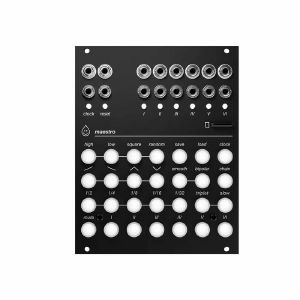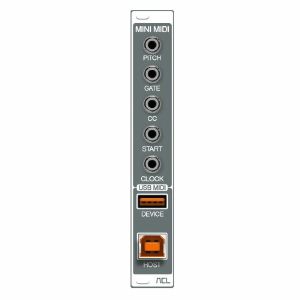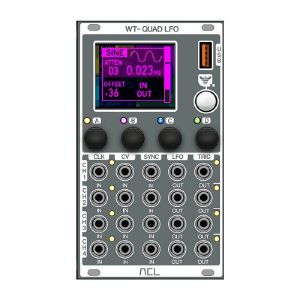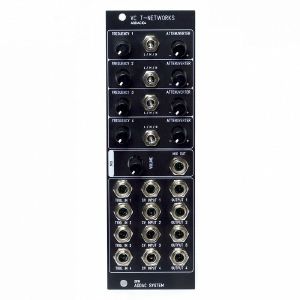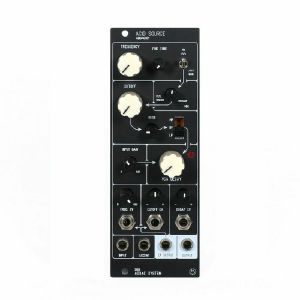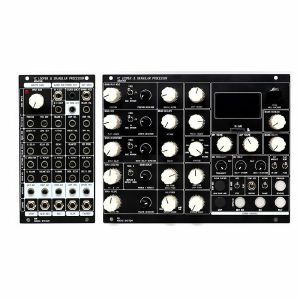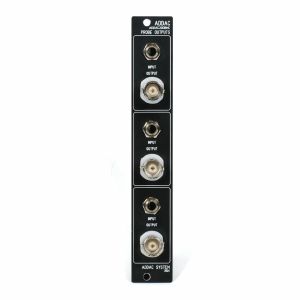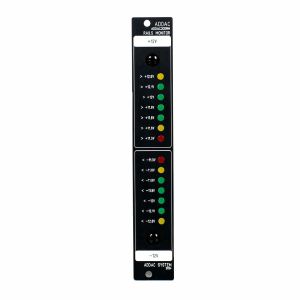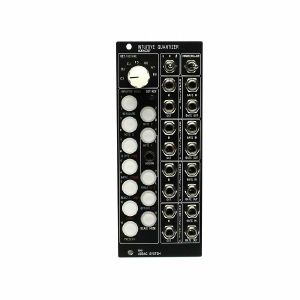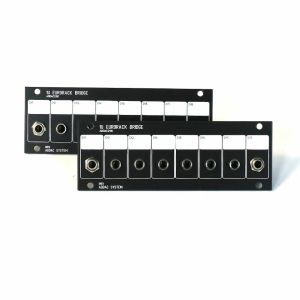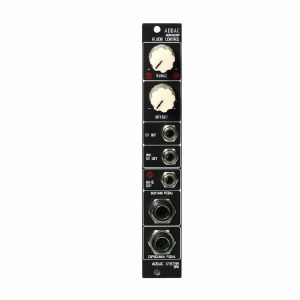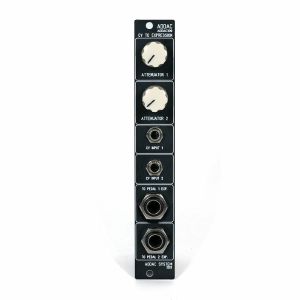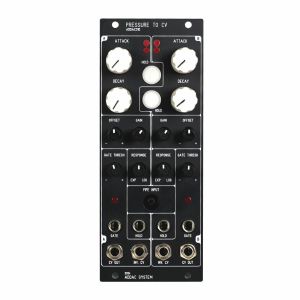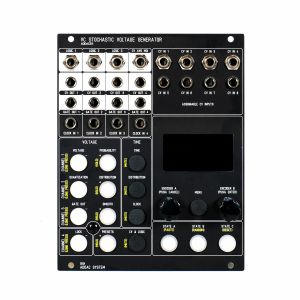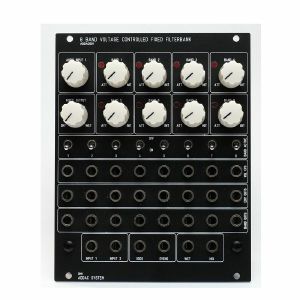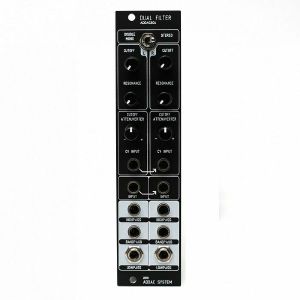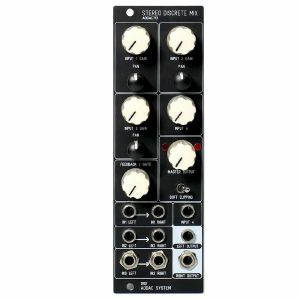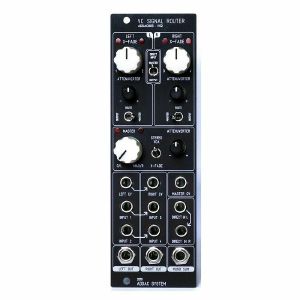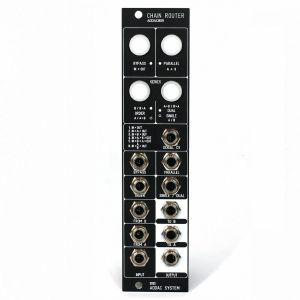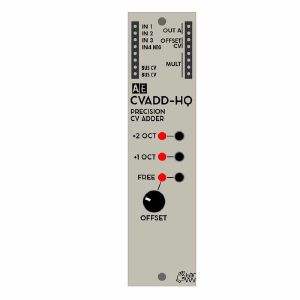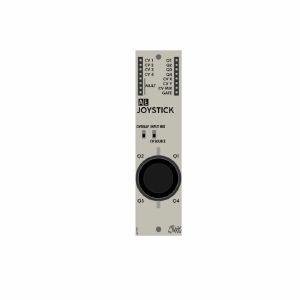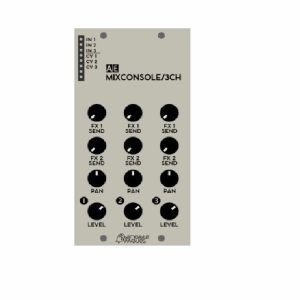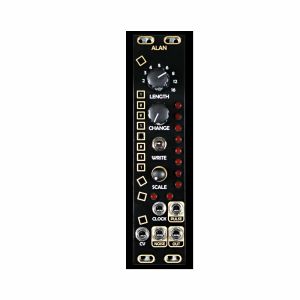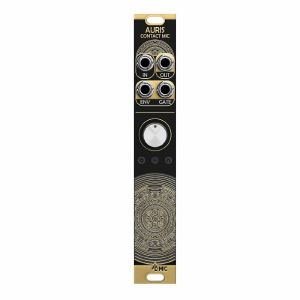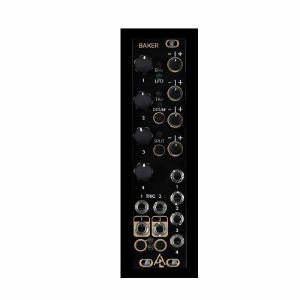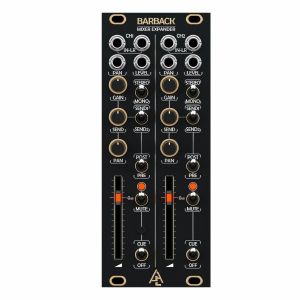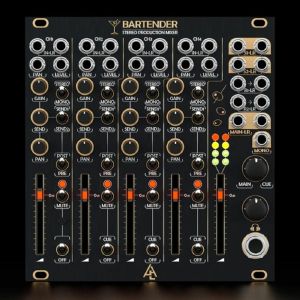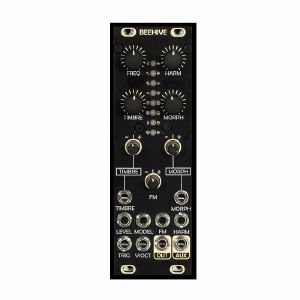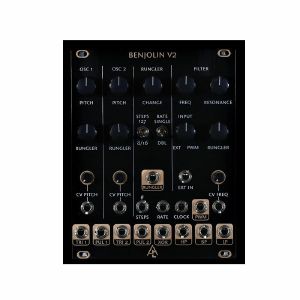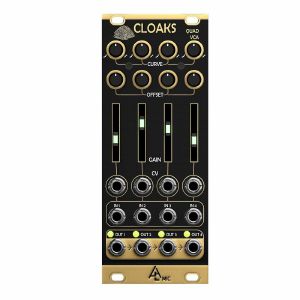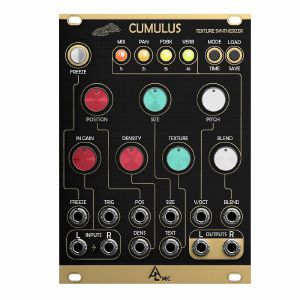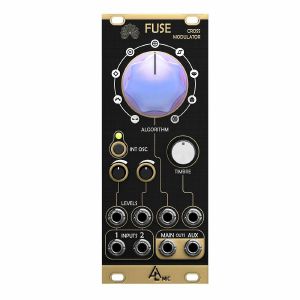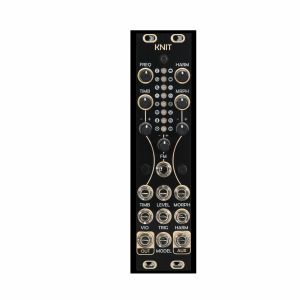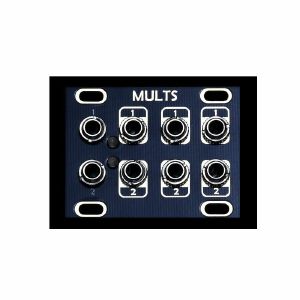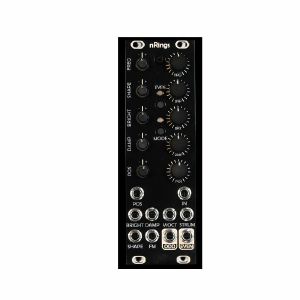Filter
Equipment
Format
Release Date
Brand
Featured
Price
Tags
Back catalogue: Studio Equipment
Juno's full catalogue of Studio EquipmentAcid Rain Technology Maestro 6-Channel Clocked Modulation Controller Module (clock generator/clock modulator/controller/CV modulation/envelope generator/LFO/random/sequencer module)
Cat: 804571 Rel: 22 Jan 21
6-channel clocked modulation module
Notes: Maestro is a 6 channel clocked modulation controller inspired by the automation lanes found in digital audio workstation software, brought into eurorack and made playable and performable. Maestro will push and pull the parameters of your other modules with rapid or slowly evolving voltages, always in perfect sync with eachother and the rest of your system.
Details:
20hp
25mm deep
65mA on +12, 18mA on -12, 0mA on 5V
… Read moreDetails:
20hp
25mm deep
65mA on +12, 18mA on -12, 0mA on 5V
1 in stock $399.47
Click for better price!
or call +44 20 7424 1960
quote 804571
quote 804571
ACL Mini MIDI USB MIDI To CV Converter Module (MIDI module)
Cat: 776679 Rel: 06 Aug 20
MIDI to CV converter module - 4HP
Notes: Mini MIDI
Want to connect your modular system to USB MIDI equipment or computer-based DAWs? Simultaneously? We did too.
With over 20+ modules and three complete modular systems in our portfolio, you'd be forgiven for thinking we're a bunch of purists, roaming the studios of Berlin by night, looking for unsuspecting copies of Ableton Live and Cubase to infect with viruses.
But nothing could be further from the truth. We love analogue hardware, and we also love the power and creativity of DAWs. We love the power and creativity of DAWs, so we've long dreamed of a module to bridge the gap between our computer, modular system, and USB MIDI devices. So we made one.
It's small, and it's MIDI
Mini MIDI draws aesthetic inspiration from a runway model... or a drumstick... or the Taipei 101. Basically it's tall and thin. Nevertheless, this simple, space-saving format contains no less than seven connections: Pitch, Gate, CC, Start, Clock, USB Device, USB Host.
Pitch and Gate are self-explanatory, taking MIDI note information (pitch and note-on/off) from your DAW / keyboard / keytar / USB-whatever, and turning it into something your modular oscillators understand.
CC receives note velocity, aftertouch, or continuous controller information from USB and spits out modular-friendly CV, ready to command anything from filter cut-off to LFO rate.
The CC value to be converted is set using rear panel DIP switches, allowing multiple Mini MIDIs to respond to different CC values from the same DAW / instrument source. You can select from 13 different CC values (if you're superstitious then Mini MIDI is not for you).
The remaining three DIP settings access three additional modes: Note Velocity and Aftertouch modes convert those signals to CV, while Calibration allows precise setting of scale and pitch offset.
Start(stop) and Clock offer no surprises, but if you have a sequencer in your rack you aren't looking for surprises, just a way to trigger it and keep it in time from your DAW and other kit. If this is you, you won't be disappointed.
USB Device lets you connect... wait for it... a USB MIDI device! An obvious use is when you want to use your favourite, gig-friendly, USB controller on stage to control that cut-off, thus keeping your real-estate-guzzling modular rack out of the way (and out of reach of that beer you have perched on a cheap M-Audio controller).
USB Host is the heart of Mini MIDI, bridging the gap between your modular system and a MIDI host device, such as a DAW or hardware MIDI sequencer.
Channel X
We thought hard about MIDI channel assignment. DIP switches are wildly impractical, as you often need to change MIDI channels. A front panel selector would increase the size of a module that's designed to be squeezed into the far left of your rack. (Far left, BTW, because then you can use angled USB connectors and avoid thick cables trailing all over your rack... ). In the end we used 'first come, first served'.
On powering up, Mini MIDI sits patiently waiting for a MIDI signal. Whichever channel it detects first - from Host or Device - is the assigned channel (if your kit is dishing out ALL channels, Mini MIDI will pick the first one... which is 1). And this assignment applies to both USB MIDI connections.
Play nicely with others
Mini MIDI also works perfectly in conjunction with other Mini MIDIs (via multiple computer USB ports or USB hubs). They show up in your system with unique IDs, so each can be triggered by different MIDI channels and/or CC controllers. This can be used to send the same information to different modules/racks in your modular set-up, different information to the same module/rack, or any combination of these. And it can incorporate other USB devices.
Another insanely useful feature is the ability to play your modular set-up live, with a MIDI keyboard or controller, whilst simultaneously recording this information into a MIDI track in your DAW.
Some ultra-modular-types might complain that this is cheating, but they should remember that our grandparents insisted anything made with machines wasn't 'real' music. Chill out and enjoy the possibilities!
Size isn't everything (and other cliches)
Despite its modest appearance, diminutive size, and total lack of front panel controls, Mini MIDI is an exceptionally powerful, highly flexible, and immeasurably useful little module. We designed it to solve the kinds of problems we encountered when using similar modules, and, critically, the kinds of problems our users said they had with other such devices. Consequently, we've exceeded our initial expectations. We hope you feel the same!
Specifications:
DAC: 16 bit
Pitch Output (1V / Octave): -3 V to 7 V
Gate Output: 0 V / 10 V
MIDI CC Output: 0 V to 5 V
MIDI Start / Stop: Active High (5 V)
MIDI Clock: Rising edge (5 V)
USB MIDI Host Interface output current: up to 500 mA
3U Eurorack module, 4 HP wide, compatible with Skiff cases
Current Draw:
+12V: ca. 22mA + current consumption of a connected class compliant USB Device , USB current supply available up to 500mA
-12V: ca. 10mA
0 mA 5V
Installation depth:
30 mm deep
… Read moreWant to connect your modular system to USB MIDI equipment or computer-based DAWs? Simultaneously? We did too.
With over 20+ modules and three complete modular systems in our portfolio, you'd be forgiven for thinking we're a bunch of purists, roaming the studios of Berlin by night, looking for unsuspecting copies of Ableton Live and Cubase to infect with viruses.
But nothing could be further from the truth. We love analogue hardware, and we also love the power and creativity of DAWs. We love the power and creativity of DAWs, so we've long dreamed of a module to bridge the gap between our computer, modular system, and USB MIDI devices. So we made one.
It's small, and it's MIDI
Mini MIDI draws aesthetic inspiration from a runway model... or a drumstick... or the Taipei 101. Basically it's tall and thin. Nevertheless, this simple, space-saving format contains no less than seven connections: Pitch, Gate, CC, Start, Clock, USB Device, USB Host.
Pitch and Gate are self-explanatory, taking MIDI note information (pitch and note-on/off) from your DAW / keyboard / keytar / USB-whatever, and turning it into something your modular oscillators understand.
CC receives note velocity, aftertouch, or continuous controller information from USB and spits out modular-friendly CV, ready to command anything from filter cut-off to LFO rate.
The CC value to be converted is set using rear panel DIP switches, allowing multiple Mini MIDIs to respond to different CC values from the same DAW / instrument source. You can select from 13 different CC values (if you're superstitious then Mini MIDI is not for you).
The remaining three DIP settings access three additional modes: Note Velocity and Aftertouch modes convert those signals to CV, while Calibration allows precise setting of scale and pitch offset.
Start(stop) and Clock offer no surprises, but if you have a sequencer in your rack you aren't looking for surprises, just a way to trigger it and keep it in time from your DAW and other kit. If this is you, you won't be disappointed.
USB Device lets you connect... wait for it... a USB MIDI device! An obvious use is when you want to use your favourite, gig-friendly, USB controller on stage to control that cut-off, thus keeping your real-estate-guzzling modular rack out of the way (and out of reach of that beer you have perched on a cheap M-Audio controller).
USB Host is the heart of Mini MIDI, bridging the gap between your modular system and a MIDI host device, such as a DAW or hardware MIDI sequencer.
Channel X
We thought hard about MIDI channel assignment. DIP switches are wildly impractical, as you often need to change MIDI channels. A front panel selector would increase the size of a module that's designed to be squeezed into the far left of your rack. (Far left, BTW, because then you can use angled USB connectors and avoid thick cables trailing all over your rack... ). In the end we used 'first come, first served'.
On powering up, Mini MIDI sits patiently waiting for a MIDI signal. Whichever channel it detects first - from Host or Device - is the assigned channel (if your kit is dishing out ALL channels, Mini MIDI will pick the first one... which is 1). And this assignment applies to both USB MIDI connections.
Play nicely with others
Mini MIDI also works perfectly in conjunction with other Mini MIDIs (via multiple computer USB ports or USB hubs). They show up in your system with unique IDs, so each can be triggered by different MIDI channels and/or CC controllers. This can be used to send the same information to different modules/racks in your modular set-up, different information to the same module/rack, or any combination of these. And it can incorporate other USB devices.
Another insanely useful feature is the ability to play your modular set-up live, with a MIDI keyboard or controller, whilst simultaneously recording this information into a MIDI track in your DAW.
Some ultra-modular-types might complain that this is cheating, but they should remember that our grandparents insisted anything made with machines wasn't 'real' music. Chill out and enjoy the possibilities!
Size isn't everything (and other cliches)
Despite its modest appearance, diminutive size, and total lack of front panel controls, Mini MIDI is an exceptionally powerful, highly flexible, and immeasurably useful little module. We designed it to solve the kinds of problems we encountered when using similar modules, and, critically, the kinds of problems our users said they had with other such devices. Consequently, we've exceeded our initial expectations. We hope you feel the same!
Specifications:
DAC: 16 bit
Pitch Output (1V / Octave): -3 V to 7 V
Gate Output: 0 V / 10 V
MIDI CC Output: 0 V to 5 V
MIDI Start / Stop: Active High (5 V)
MIDI Clock: Rising edge (5 V)
USB MIDI Host Interface output current: up to 500 mA
3U Eurorack module, 4 HP wide, compatible with Skiff cases
Current Draw:
+12V: ca. 22mA + current consumption of a connected class compliant USB Device , USB current supply available up to 500mA
-12V: ca. 10mA
0 mA 5V
Installation depth:
30 mm deep
1 in stock $273.32
Cat: 824302 Rel: 01 Nov 24
Quad wavetable-based low frequency oscillator module - 14HP
Notes: The WT-QUAD-LFO module consists of four individual, digital, wavetable based low frequency oscillators (LFO) with an easy and intuitive featuring a 1.8" OLED color display. The module can be updated easily by inserting a flash drive with the firmware files in the USB port on the front panel.
The oscillators and their respective controls, inputs and outputs are organized in four channels. The frequency of each oscillator can be linearly or exponentially (1V/Oct.) controlled through the voltage applied to the corresponding CV input.
Each LFO channel can output one of the predefined waveforms (including sawtooth, ramp, square, sine, triangle), morph between two different waveforms or generate a random waveform. It can be externally reset through the sync input.
Each trigger output can be set to output a specific phase of the corresponding waveform.
The module offers cross frequency modulation (FM) and internal sync between LFO channels. It features also phase distortion and phase spreading of the outputs, including a classical quadrature mode (90- phase spread). Frequency relationships between the four LFOs can also be set.
Hardware
4x CV inputs -5 V to +5 V
4x Sync inputs 0 V to 5 V, active low or active high
4x Clock inputs 0 V to 5 V, active low or active high
4x LFO outputs -5 V to +5 V
4x Trigger outputs 0 V to 10 V, active low or active high
1.8" OLED Display with 160 x 128 pixel
4x push encoder
USB port for firmware update
Size: 14HP
WT-QUAD LFO - Features list:
Wavetable based, 4 channel LFO
Default waveforms: SAW, SQUARE, SINE TRIANGLE
Random waveform generation
Custom wavetables can be loaded using USB flash drive
LFO output: offset and attenuation programmable
LFO Frequency range from 0,0032 Hz to 4 kHz
Frequency free (Hz) or quantized (note)
Presets can be selected through CV input
LFO channel can be internally synced and cross modulated
Single shot modus
… Read moreThe oscillators and their respective controls, inputs and outputs are organized in four channels. The frequency of each oscillator can be linearly or exponentially (1V/Oct.) controlled through the voltage applied to the corresponding CV input.
Each LFO channel can output one of the predefined waveforms (including sawtooth, ramp, square, sine, triangle), morph between two different waveforms or generate a random waveform. It can be externally reset through the sync input.
Each trigger output can be set to output a specific phase of the corresponding waveform.
The module offers cross frequency modulation (FM) and internal sync between LFO channels. It features also phase distortion and phase spreading of the outputs, including a classical quadrature mode (90- phase spread). Frequency relationships between the four LFOs can also be set.
Hardware
4x CV inputs -5 V to +5 V
4x Sync inputs 0 V to 5 V, active low or active high
4x Clock inputs 0 V to 5 V, active low or active high
4x LFO outputs -5 V to +5 V
4x Trigger outputs 0 V to 10 V, active low or active high
1.8" OLED Display with 160 x 128 pixel
4x push encoder
USB port for firmware update
Size: 14HP
WT-QUAD LFO - Features list:
Wavetable based, 4 channel LFO
Default waveforms: SAW, SQUARE, SINE TRIANGLE
Random waveform generation
Custom wavetables can be loaded using USB flash drive
LFO output: offset and attenuation programmable
LFO Frequency range from 0,0032 Hz to 4 kHz
Frequency free (Hz) or quantized (note)
Presets can be selected through CV input
LFO channel can be internally synced and cross modulated
Single shot modus
2 in stock $527.83
Click for better price!
or call +44 20 7424 1960
quote 824302
quote 824302
ADDAC System ADDAC104 VC T-Networks Module (drum/quad synth module)
Cat: 776116 Rel: 08 Sep 20
4 voice module
Notes: Following the ADDAC103 T-Networks, this new module is also inspired by Twin T-Networks circuits used in many lengendary drum machines. A simple 4 voice module with frequency controls for each of the voices. This new module also features CV inputs with attenuverters for each voice Frequency. Due to the specificities of the circuit, and to keep the module at a low price, these inputs are not callibrated to 1v/octave.
At each voice input there's a gate to trigger converter so any input source is possible.
Audio inputs can also be used as an input, in this case and due to the nature of the gate to trigger converter, each voice can be used as very destructive filters.
The top 2 channels feature a higher frequency range, the bottom 2 channels feature a lower frequency range.
… Read moreAt each voice input there's a gate to trigger converter so any input source is possible.
Audio inputs can also be used as an input, in this case and due to the nature of the gate to trigger converter, each voice can be used as very destructive filters.
The top 2 channels feature a higher frequency range, the bottom 2 channels feature a lower frequency range.
2 in stock $171.51
Click for better price!
or call +44 20 7424 1960
quote 776116
quote 776116
ADDAC System ADDAC107 Acid Source Synth Voice Module (B-STOCK) (synth voice synth module)
Cat: 1084407 Rel: 01 Jan 90
B-STOCK: Product with some signs of usage but in perfect working order
Notes: ***B-STOCK: Product with some signs of usage but in perfect working order***
A fresh twist on a simple 303-style acid synth, featuring a triangle/sawtooth/square wave VCO, multi-mode resonant filter, simple AD envelope and a VCA which can be overdriven. Excellent value.
Supplier's Notes:
ADDAC started this module with the idea of developing a complex drum source however, somewhere along the process, it was clear how much better it performed as a synth voice and this lucky accident was embraced.
It features a VCO with a [FREQUENCY] and [FINE TUNE] knob plus a dedicated CV Input and Attenuator knob (tunable over 4 octaves).
The VCO waveform output is achieved by selecting either a Triangle or Saw through a switch. the selected waveform can then be mixed/balanced against the square wave. The resulting mix is then sent to the Filter.
The Filter features a [CUTOFF] and [RESO] resonance knob plus a Cutoff CV Input and Attenuverter knob.
A 3 position switch is used to select the filter type: Highpass, Bandpass or Lowpass.
The resulting output is then sent to the VCA.
The VCA features an Input with [INPUT GAIN] knob which at maximum can amplify the incoming signal by a factor of 2.
This is a very important control, it accepts any signal Trigger, Gate or CV. Whatever input is plugged in the signal is then fed through an AD with a very short attack and controllable decay through the [VCA DECAY] knob plus the CV Input and Attenuverter knob. The resulting slewed signal is then used to control the VCA gain.
This signal is also sent to the CV OUTPUT as well as the LED monitor.
The Accent input adds to the Input signal creating a different amplitude output.
The CV OUTPUT is normalled to the Frequency and Cutoff inputs.
Tech Specs:
9HP
4cm deep
80mA +12V
80mA -12V
The [INPUT GAIN] knob
Usually Attack/Decay envelopes have a maximum voltage of +5v, no matter if the input gate is +5v or above the AD will clip at +5v. In this case, this clipping method was not used, and instead ADDAC allowed the incoming voltage to determine the maximum AD voltage, meaning that if a +5v gate is present then the AD maximum voltage will be +5v but if a gate of +10v is sent then the AD maximum voltage will be +10v.
This also means that with higher input voltages the decay, although falling at the same speed, will be longer than with lower voltages as it has a longer range to go back to 0v.
As previously mentioned, The [INPUT GAIN] knob can amplify the incoming input by a factor of 2, allowing to use a standard +5v gate or envelope and being able to make the resultant AD go up to +10v.
The AD signal is responsible for opening the VCA. Up to +5v the VCA will open to unity gain above this value the VCA will start to amplify and eventually saturate and distort. This saturation will add harmonics to the signal which will change its gentle timbrical nature to a more unique and peculiar timbre that will make the module shine in Acid contexts.
Adding high levels of Resonance or even filter self oscillation in combination with high VCA saturation will create even more harmonics that ADDAC highly encourage the user to explore.
… Read moreA fresh twist on a simple 303-style acid synth, featuring a triangle/sawtooth/square wave VCO, multi-mode resonant filter, simple AD envelope and a VCA which can be overdriven. Excellent value.
Supplier's Notes:
ADDAC started this module with the idea of developing a complex drum source however, somewhere along the process, it was clear how much better it performed as a synth voice and this lucky accident was embraced.
It features a VCO with a [FREQUENCY] and [FINE TUNE] knob plus a dedicated CV Input and Attenuator knob (tunable over 4 octaves).
The VCO waveform output is achieved by selecting either a Triangle or Saw through a switch. the selected waveform can then be mixed/balanced against the square wave. The resulting mix is then sent to the Filter.
The Filter features a [CUTOFF] and [RESO] resonance knob plus a Cutoff CV Input and Attenuverter knob.
A 3 position switch is used to select the filter type: Highpass, Bandpass or Lowpass.
The resulting output is then sent to the VCA.
The VCA features an Input with [INPUT GAIN] knob which at maximum can amplify the incoming signal by a factor of 2.
This is a very important control, it accepts any signal Trigger, Gate or CV. Whatever input is plugged in the signal is then fed through an AD with a very short attack and controllable decay through the [VCA DECAY] knob plus the CV Input and Attenuverter knob. The resulting slewed signal is then used to control the VCA gain.
This signal is also sent to the CV OUTPUT as well as the LED monitor.
The Accent input adds to the Input signal creating a different amplitude output.
The CV OUTPUT is normalled to the Frequency and Cutoff inputs.
Tech Specs:
9HP
4cm deep
80mA +12V
80mA -12V
The [INPUT GAIN] knob
Usually Attack/Decay envelopes have a maximum voltage of +5v, no matter if the input gate is +5v or above the AD will clip at +5v. In this case, this clipping method was not used, and instead ADDAC allowed the incoming voltage to determine the maximum AD voltage, meaning that if a +5v gate is present then the AD maximum voltage will be +5v but if a gate of +10v is sent then the AD maximum voltage will be +10v.
This also means that with higher input voltages the decay, although falling at the same speed, will be longer than with lower voltages as it has a longer range to go back to 0v.
As previously mentioned, The [INPUT GAIN] knob can amplify the incoming input by a factor of 2, allowing to use a standard +5v gate or envelope and being able to make the resultant AD go up to +10v.
The AD signal is responsible for opening the VCA. Up to +5v the VCA will open to unity gain above this value the VCA will start to amplify and eventually saturate and distort. This saturation will add harmonics to the signal which will change its gentle timbrical nature to a more unique and peculiar timbre that will make the module shine in Acid contexts.
Adding high levels of Resonance or even filter self oscillation in combination with high VCA saturation will create even more harmonics that ADDAC highly encourage the user to explore.
1 in stock $206.93
ADDAC System ADDAC112A&B VC Looper & Granular Processor Module (sampling synth module)
Cat: 811085 Rel: 07 Sep 21
VC looper & granular processor module - 45HP
Notes: One of the most impressive granular synthesis approaches in Eurorack, combining looping and granular effects with buffer sizes up to five minutes. Hugely creative and powerful dual-module setup.
Supplier's Notes:
There's a long history behind the granular concept and many reinterpretations of it's core principles, this is ADDAC's take on it.
In a loose description digital Granular refer to pieces of sound files being played at the same time with slight or completely different parameters originating what is commonly referred to as granular clouds. Normally there's a buffer size from which the granular engine snips it's pieces from and plays them according to the parameters set. This buffer size is normally small in size where grains are so small that can reach the hearing spectrum and be heard as a sort of ever changing complex wavetable, this is the principle behind granular synthesis.
ADDAC have added the possibility of long buffer sizes up to 5 minutes, allowing "softer" approaches to the granular principle using it as an effect that can generate from "accidental" effects like slight "stutters" to extreme processing and transformation of any incoming audio signal.
This module is conceptually deep but easy to grasp and operate as all controls are in its dedicated panel, all jack inputs and outputs have its own separate panel to allow no compromise when playing it's controls.
There are three main sections in this module:
Looper Engine: The Looper is where all the Real-Time recording happens. The audio input feeds the recording buffer, multiple controls allow to record and play loops into a list so that any sample in the list can be accessed at ay time and more acting as a standard looper
Granular Engine: The Granular acts upon the buffer of whatever LOOP is selected.
Output Mix The output mix allow individual control for the Dry Input, Looper Volume and Grains Volume.
Besides these main sections there's also a simple strip down MENU mainly used to LOAD and SAVE Banks, no Menu diving guaranteed.
For more detailed info, please refer to the User's Guide.
Audio Specs:
Audio input: Stereo, 16bit 44.1Khz
Audio output: Stereo, 16bit 44.1Khz
Tech Specs:
32HP + 13HP
4.5cm deep
240mA +12V
70mA -12V
… Read moreSupplier's Notes:
There's a long history behind the granular concept and many reinterpretations of it's core principles, this is ADDAC's take on it.
In a loose description digital Granular refer to pieces of sound files being played at the same time with slight or completely different parameters originating what is commonly referred to as granular clouds. Normally there's a buffer size from which the granular engine snips it's pieces from and plays them according to the parameters set. This buffer size is normally small in size where grains are so small that can reach the hearing spectrum and be heard as a sort of ever changing complex wavetable, this is the principle behind granular synthesis.
ADDAC have added the possibility of long buffer sizes up to 5 minutes, allowing "softer" approaches to the granular principle using it as an effect that can generate from "accidental" effects like slight "stutters" to extreme processing and transformation of any incoming audio signal.
This module is conceptually deep but easy to grasp and operate as all controls are in its dedicated panel, all jack inputs and outputs have its own separate panel to allow no compromise when playing it's controls.
There are three main sections in this module:
Looper Engine: The Looper is where all the Real-Time recording happens. The audio input feeds the recording buffer, multiple controls allow to record and play loops into a list so that any sample in the list can be accessed at ay time and more acting as a standard looper
Granular Engine: The Granular acts upon the buffer of whatever LOOP is selected.
Output Mix The output mix allow individual control for the Dry Input, Looper Volume and Grains Volume.
Besides these main sections there's also a simple strip down MENU mainly used to LOAD and SAVE Banks, no Menu diving guaranteed.
For more detailed info, please refer to the User's Guide.
Audio Specs:
Audio input: Stereo, 16bit 44.1Khz
Audio output: Stereo, 16bit 44.1Khz
Tech Specs:
32HP + 13HP
4.5cm deep
240mA +12V
70mA -12V
3 in stock $603.30
ADDAC System ADDAC200BNC Probe Outputs Module (modular synthesiser)
Cat: 1031331 Rel: 13 Sep 24
Probe outputs module - 4HP
Notes: A passive module to allow easy connection from Modular to Eurorack, avoid flimsy hook probes or alligator wires with a robust connection that will keep your signal intact.
Features:
3.5mm jack to BNC including 50O male-male cables.
Ships calibrated set to 10x as default, user's can select 1x but soldering a smd jumper.
Specs:
4HP
15mm deep
Passive
… Read moreFeatures:
3.5mm jack to BNC including 50O male-male cables.
Ships calibrated set to 10x as default, user's can select 1x but soldering a smd jumper.
Specs:
4HP
15mm deep
Passive
3 in stock $107.33
Click for better price!
or call +44 20 7424 1960
quote 1031331
quote 1031331
ADDAC System ADDAC200PI Dual Pedal Integrator Module (dual/stereo/external synth module)
Cat: 776156 Rel: 09 Sep 20
Pedal integrator module
Notes: This small utility is the pedal's lover best friend, it allows 2 diferent chains of pedals to be independently connected to your synth.
The Send channels attenuate the synth level to instrument level.
The Return channels amplify the signal from instrument to synth level.
Specs:
- Width: 4 HP
- Depth: 3 cm
- Max current: 10mA
… Read moreThe Send channels attenuate the synth level to instrument level.
The Return channels amplify the signal from instrument to synth level.
Specs:
- Width: 4 HP
- Depth: 3 cm
- Max current: 10mA
3 in stock $108.44
ADDAC System ADDAC200RM Rails Monitor Module (modular synthesiser)
Cat: 1028712 Rel: 13 Sep 24
LED voltage meter module - 4HP
Notes: ADDAC200RM allows a simple and straight forward way to monitor the voltage of your system. A 0.1% precision analogue voltage meter shows the status of both +12V and -12V rail.
Eurorack +/-12V power rails
Although we all refer to Eurorack PSU voltages as +12V and -12V this is hardly ever the case, although most systems operate at close proximity to this ideal reference, there are situations where the drop from the ideal voltage is large enough to influence the performance of your system.
PSU current ratings
Running a PSU too close to its limits will always cause more stress to the PSU, a good practice it to use only about 75% of your PSU maximum ratings, this will greatly extend the PSU life.
PSUs will show a small voltage drop as current increases which will drastically increase when pushed closed to it's limits. Heat will also influence this drop, heat is related to the current drawn, as more current is being drawn more heat will build up on the PSU, heat conditions will reduce the maxi- mum amount of current that can be delivered by the PSU. While the current consumption drop is somewhat stable and immediate (as you turn the frame on the current consumption will stabilize in a few seconds) the heat drop will take some time to occur, heat will build up over time until it stabilizes and only if it has "headroom" to stabilize. If heat dissipation is not effective than the drop will continue until it reaches a balance point which can be several volts below the 12V reference. At this point your PSU will be under great stress and the heat generated is prone to leave some permanent scars.
Heat will start to have an impact at about an ambient temperature of 50 degrees celsius, at 70 degrees the maxi- mum current rating will drop by 50%. If your PSU is rated at 2A maximum and it's running at 70 degrees then it will only be able to deliver 1A maximum.
For the PSU this is a complex balancing act as current influences heat and heat influences the maximum amount of current available which all together influences the voltage drop.
This is why it's so important to keep the PSU load at a sensible level.
PSU protections
Some PSUs feature over voltage, over current and overheating protection and will turn off when the operating conditions trigger any of the protection threshold levels.
At this point it's typical that the PSU will enter a Hiccup mode, where it turns on checks the current conditions and quickly turns off if they haven't changed, leaving it in an intermittent limbo where it powers on and off at some regular frequency.
If the conditions change enough to drop below the protection threshold levels then the PSU will automatically recover and stay on.
PSU stress
Different situations can be responsible for causing stress that can damage the PSU, it's possible to reverse a ribbon power cable enough times or leaving it connected long enough to partly damage the PSU.
Another situation is having a module that due to some partial previous damage may be drawing more current than specified which will not be accounted for when calculating your system current consumption.
Stress can cause permanent damage to the PSU, however some damages can be only partial leaving you with a PSU that no longer features the specs described by the manufacturer but with no apparent misbehaviour. The LED monitors on bus boards will be on, but in reality it will be underperforming at an unknown percentage of the original specs. These situations can be quite hard to debug without the proper tools to evaluate the cause of the problem.
PSU impact on modules
Some modules are more susceptible to PSU changes than others, modules that feature internal regulators will be less susceptible to PSU voltage, modules that use internal +5v, +/-9v, +/-10v regulators will have more tolerance than modules that use the PSU voltages directly like it is for most cases. Also modules that use voltage reverse protection will already have a 0.3v to 0.8v drop inherent to the protection circuit.
While many digital modules can withstand lower voltages some others will be more dependent on the reference voltage and may show strange behaviours.
This module can help preventing all these situations, it won't fix any problem but can help on the day-to-day monitoring of your system and in keeping your PSU in healthy conditions.
Tech Specs: 4HP/3,5 cm deep
60mA +12V
60mA -12V
… Read moreEurorack +/-12V power rails
Although we all refer to Eurorack PSU voltages as +12V and -12V this is hardly ever the case, although most systems operate at close proximity to this ideal reference, there are situations where the drop from the ideal voltage is large enough to influence the performance of your system.
PSU current ratings
Running a PSU too close to its limits will always cause more stress to the PSU, a good practice it to use only about 75% of your PSU maximum ratings, this will greatly extend the PSU life.
PSUs will show a small voltage drop as current increases which will drastically increase when pushed closed to it's limits. Heat will also influence this drop, heat is related to the current drawn, as more current is being drawn more heat will build up on the PSU, heat conditions will reduce the maxi- mum amount of current that can be delivered by the PSU. While the current consumption drop is somewhat stable and immediate (as you turn the frame on the current consumption will stabilize in a few seconds) the heat drop will take some time to occur, heat will build up over time until it stabilizes and only if it has "headroom" to stabilize. If heat dissipation is not effective than the drop will continue until it reaches a balance point which can be several volts below the 12V reference. At this point your PSU will be under great stress and the heat generated is prone to leave some permanent scars.
Heat will start to have an impact at about an ambient temperature of 50 degrees celsius, at 70 degrees the maxi- mum current rating will drop by 50%. If your PSU is rated at 2A maximum and it's running at 70 degrees then it will only be able to deliver 1A maximum.
For the PSU this is a complex balancing act as current influences heat and heat influences the maximum amount of current available which all together influences the voltage drop.
This is why it's so important to keep the PSU load at a sensible level.
PSU protections
Some PSUs feature over voltage, over current and overheating protection and will turn off when the operating conditions trigger any of the protection threshold levels.
At this point it's typical that the PSU will enter a Hiccup mode, where it turns on checks the current conditions and quickly turns off if they haven't changed, leaving it in an intermittent limbo where it powers on and off at some regular frequency.
If the conditions change enough to drop below the protection threshold levels then the PSU will automatically recover and stay on.
PSU stress
Different situations can be responsible for causing stress that can damage the PSU, it's possible to reverse a ribbon power cable enough times or leaving it connected long enough to partly damage the PSU.
Another situation is having a module that due to some partial previous damage may be drawing more current than specified which will not be accounted for when calculating your system current consumption.
Stress can cause permanent damage to the PSU, however some damages can be only partial leaving you with a PSU that no longer features the specs described by the manufacturer but with no apparent misbehaviour. The LED monitors on bus boards will be on, but in reality it will be underperforming at an unknown percentage of the original specs. These situations can be quite hard to debug without the proper tools to evaluate the cause of the problem.
PSU impact on modules
Some modules are more susceptible to PSU changes than others, modules that feature internal regulators will be less susceptible to PSU voltage, modules that use internal +5v, +/-9v, +/-10v regulators will have more tolerance than modules that use the PSU voltages directly like it is for most cases. Also modules that use voltage reverse protection will already have a 0.3v to 0.8v drop inherent to the protection circuit.
While many digital modules can withstand lower voltages some others will be more dependent on the reference voltage and may show strange behaviours.
This module can help preventing all these situations, it won't fix any problem but can help on the day-to-day monitoring of your system and in keeping your PSU in healthy conditions.
Tech Specs: 4HP/3,5 cm deep
60mA +12V
60mA -12V
1 in stock $119.50
Click for better price!
or call +44 20 7424 1960
quote 1028712
quote 1028712
ADDAC System ADDAC207 Intuitive Quantizer Module (quantizer/quad synth module)
Cat: 776182 Rel: 08 Sep 20
Quantizer module
Notes: 4 Voices of Quantization with a 10 octave range.
Mechanical:
Format: Eurorack
Width: 10 HP
Depth: 5.2 cm
Control Voltage I/O:
CV inputs: i 5v
CV outputs: +10v
Electrical:
Max current: +140mA/-70mA
Bus Board Cable: 8 × 2 IDC (Doepfer style) connector
… Read moreMechanical:
Format: Eurorack
Width: 10 HP
Depth: 5.2 cm
Control Voltage I/O:
CV inputs: i 5v
CV outputs: +10v
Electrical:
Max current: +140mA/-70mA
Bus Board Cable: 8 × 2 IDC (Doepfer style) connector
2 in stock $399.47
Click for better price!
or call +44 20 7424 1960
quote 776182
quote 776182
ADDAC System ADDAC213C 1U Eurorack Bridge Modules (pair) (utility synth module)
Cat: 944228 Rel: 14 Sep 23
An 1U utility module in 22HP.
Notes: A pair of ADDAC213Cs can be used in standalone to send/receive 8 CV or audio signals between different points inside the same case or as an expansion to the main pair of Eurorack Bridge modules, the ADDAC213As.
Standalone use:
Two ADDAC213C modules can be connected to each other with the use of a single ribbon cable and then used inside a case to carry signals between distant points without the need for long cables. Less clutter, less spaghetti, more space of your fingers on those knobs!
ADDAC213Cs always come in pairs. A single pair can send & receive up to 8 CV or audio signals between different points in your case at the same time.
Do you have modules that you often use together in different areas of your case? Would you prefer that each row's cables don't mingle with cables from other rows? Grab yourself a pair of ADDAC213s.
As an Expansion to an ADDAC213A:
Each ADDAC213C connected to the backside of an ADDAC213A adds 8 more channels to the main bridging functionality of the ADDAC213A.
Up to 2 ADDAC213C can be connected to an ADDAC213A module, expanding the bridging between two difference cases to a total of 24 channels.
If you're looking for a simple one-cable bridge between your various cases, then look no further than the ADDAC213A.
Between the ADDAC213A pair and the ADDAC213B, your cases never looked so elegantly connected together!
Check ADDAC213A for more information:
https://www.addacsystem.com/en/products/modules/addac200-series/addac213a
Price is for a pair of modules (2 modules) including two 50cm ribbon cables, only one is used to connect the two ADDAC213C together but two are necessary when connecting the two ADDAC213C to two ADDAC213A.
Comes with a 50cm ribbon cable. Custom sizes are available upon request.
Mechanical:
. Format: 1U Eurorack
. Width: 22HP
. Depth: 2.5 cm
Electrical:
Passive / Does not draw current
Ribbon Cable: 50cm or 100cm ribbon cable (custom sizes available upon request)
… Read moreStandalone use:
Two ADDAC213C modules can be connected to each other with the use of a single ribbon cable and then used inside a case to carry signals between distant points without the need for long cables. Less clutter, less spaghetti, more space of your fingers on those knobs!
ADDAC213Cs always come in pairs. A single pair can send & receive up to 8 CV or audio signals between different points in your case at the same time.
Do you have modules that you often use together in different areas of your case? Would you prefer that each row's cables don't mingle with cables from other rows? Grab yourself a pair of ADDAC213s.
As an Expansion to an ADDAC213A:
Each ADDAC213C connected to the backside of an ADDAC213A adds 8 more channels to the main bridging functionality of the ADDAC213A.
Up to 2 ADDAC213C can be connected to an ADDAC213A module, expanding the bridging between two difference cases to a total of 24 channels.
If you're looking for a simple one-cable bridge between your various cases, then look no further than the ADDAC213A.
Between the ADDAC213A pair and the ADDAC213B, your cases never looked so elegantly connected together!
Check ADDAC213A for more information:
https://www.addacsystem.com/en/products/modules/addac200-series/addac213a
Price is for a pair of modules (2 modules) including two 50cm ribbon cables, only one is used to connect the two ADDAC213C together but two are necessary when connecting the two ADDAC213C to two ADDAC213A.
Comes with a 50cm ribbon cable. Custom sizes are available upon request.
Mechanical:
. Format: 1U Eurorack
. Width: 22HP
. Depth: 2.5 cm
Electrical:
Passive / Does not draw current
Ribbon Cable: 50cm or 100cm ribbon cable (custom sizes available upon request)
2 in stock $87.42
ADDAC System ADDAC215 Dual S&H+ Module (dual/stereo/sample & hold/slew limiter/random synth module)
Cat: 776254 Rel: 08 Sep 20
Dual sample & holds module
Notes: This new module should not be judged by it's size, at 6hp it's packed with features.
At its core it features a noise source and two precision Sample & Holds with 0.01% of maximum deviation from the Input which allows for quantized signals to be sent through without any noticeable detuning or the typical voltage drops over time.
The Sample & Hold sections can also be used as a Track & Hold meaning it holds the incoming input while the Trigger input is ON and lets the input flow to the output when the Trigger input is OFF.
Each section also features it's own slew processor with a single control over attack and decay and an ON/OFF switch.
The noise signal is normalled to both sections inputs, meaning that without a jack plugged into the Input the sample and hold function will act upon the incoming noise signal generating random CV values.
The [Trigger A Alternate] switch allows to Link both sections so that any trigger input in Trigger A will alternate between triggering the A and B section.
Besides each section outputs there's also 4 extra outputs: Noise, Difference, Average and Sum. The Noise output is coming from the noise source, the Difference output is the subtraction of section A minus section B, the Average output is the sum of both A plus B and then divided by 2 and finally the Sum output is the sum of both A plus B sections.
MECHANICAL:
Format: Eurorack
Width: 6 HP
Depth: 4 cm
ELECTRICAL:
Max current: +50mA/-50mA
Bus Board Cable: 8 × 2 IDC (Doepfer style) connector
… Read moreAt its core it features a noise source and two precision Sample & Holds with 0.01% of maximum deviation from the Input which allows for quantized signals to be sent through without any noticeable detuning or the typical voltage drops over time.
The Sample & Hold sections can also be used as a Track & Hold meaning it holds the incoming input while the Trigger input is ON and lets the input flow to the output when the Trigger input is OFF.
Each section also features it's own slew processor with a single control over attack and decay and an ON/OFF switch.
The noise signal is normalled to both sections inputs, meaning that without a jack plugged into the Input the sample and hold function will act upon the incoming noise signal generating random CV values.
The [Trigger A Alternate] switch allows to Link both sections so that any trigger input in Trigger A will alternate between triggering the A and B section.
Besides each section outputs there's also 4 extra outputs: Noise, Difference, Average and Sum. The Noise output is coming from the noise source, the Difference output is the subtraction of section A minus section B, the Average output is the sum of both A plus B and then divided by 2 and finally the Sum output is the sum of both A plus B sections.
MECHANICAL:
Format: Eurorack
Width: 6 HP
Depth: 4 cm
ELECTRICAL:
Max current: +50mA/-50mA
Bus Board Cable: 8 × 2 IDC (Doepfer style) connector
1 in stock $139.42
ADDAC System ADDAC219IN Stereo To Dual Mono In Module (preamp synth module)
Cat: 1052227 Rel: 12 Dec 24
Analogue CV utilities module - 3hp
Notes: ADDAC219IN was designed to replace bulky 1/4 inch jacks when plugging external stereo gear into the modular realm.
Using a 3.5mm TRS stereo jack input, the module splits the TRS stereo signal into 2 mono outputs (Left + Right) while also converting the line input to synth level.
There are 2 independent sections allowing for two stereo sources to be connected.
Tech Specs: 3HP, 4 cm deep, 20mA +12V, 20mA -12V
… Read moreUsing a 3.5mm TRS stereo jack input, the module splits the TRS stereo signal into 2 mono outputs (Left + Right) while also converting the line input to synth level.
There are 2 independent sections allowing for two stereo sources to be connected.
Tech Specs: 3HP, 4 cm deep, 20mA +12V, 20mA -12V
2 in stock $81.06
Click for better price!
or call +44 20 7424 1960
quote 1052227
quote 1052227
ADDAC System ADDAC219OUT Dual Mono To Stereo Out Module (modular synthesiser)
Cat: 1052230 Rel: 12 Dec 24
Analogue CV utilities module - 3hp
Notes: ADDAC219OUT was designed to replace bulky 1/4-inch cables when plugging external stereo gear to the modular realm.
It merges 2 TS mono signals (Left + Right) into a TRS stereo output while also converts the synth inputs to line level.
There are 3 independent sections allowing for three stereo sources to be connected.
Tech Specs: 3HP, 1.5 cm deep, Passive module
… Read moreIt merges 2 TS mono signals (Left + Right) into a TRS stereo output while also converts the synth inputs to line level.
There are 3 independent sections allowing for three stereo sources to be connected.
Tech Specs: 3HP, 1.5 cm deep, Passive module
3 in stock $92.94
Click for better price!
or call +44 20 7424 1960
quote 1052230
quote 1052230
ADDAC System ADDAC301 Floor Control Module (controller/external synth module)
Cat: 776281 Rel: 08 Sep 20
Floor control module
Notes: While ADDAC were working on the new VC Stompboxes several expression pedals were tested and it became clear that most often, while playing a modular system, your hands are busy.
It's also normal to have an expression pedal lying around somewhere, so ADDAC have brought these back, cleaned up the dust and put them to good use.
This module allows the connection of any standard expression and sustain pedal.
The expression pedal action can be fine-tuned with Range and Offset knobs.
Range defines the voltage range (-10v, +10v).
Offset transposes the range by (-5v, +5v).
Two leds, plus and minus, monitor the CV Output
Positive and inverted output jacks.
The sustain pedal action will generate a gate signal on the gate output.
One led monitors this output.
The module also features a bus board +5v Adaptor, this will be able to provide +5v to any bus board.
This feature can be removed through a jumper on the back of the module.
Specs:
- Width: 4 HP
- Depth: 4 cm
- Max current: 20mA
. Bus Board Cable: 8 × 2 IDC (Doepfer style) connector
… Read moreIt's also normal to have an expression pedal lying around somewhere, so ADDAC have brought these back, cleaned up the dust and put them to good use.
This module allows the connection of any standard expression and sustain pedal.
The expression pedal action can be fine-tuned with Range and Offset knobs.
Range defines the voltage range (-10v, +10v).
Offset transposes the range by (-5v, +5v).
Two leds, plus and minus, monitor the CV Output
Positive and inverted output jacks.
The sustain pedal action will generate a gate signal on the gate output.
One led monitors this output.
The module also features a bus board +5v Adaptor, this will be able to provide +5v to any bus board.
This feature can be removed through a jumper on the back of the module.
Specs:
- Width: 4 HP
- Depth: 4 cm
- Max current: 20mA
. Bus Board Cable: 8 × 2 IDC (Doepfer style) connector
5 in stock $84.10
ADDAC System ADDAC304 Manual Gates Module (switch synth module)
Cat: 776300 Rel: 15 Sep 20
Manual gates module
Notes: With the ADDAC304 Manual Gates, you'll be getting 8 manual gates (0 +5v) in a nifty package - a perfect way to perform on and control your modular system.
The ADDAC304 comes with an interesting twist: 4 out of the 8 available gates can act as momentary switches, outputting the signals in their respective inputs when each gate's button is pressed.
MECHANICAL:
Format: Eurorack
Width: 8 HP
Depth: 2.5 cm
CONTROL VOLTAGE I/O:
CV inputs: i 10v
Gate outputs: 0 +5v
ELECTRICAL:
Max current: 10mA
… Read moreThe ADDAC304 comes with an interesting twist: 4 out of the 8 available gates can act as momentary switches, outputting the signals in their respective inputs when each gate's button is pressed.
MECHANICAL:
Format: Eurorack
Width: 8 HP
Depth: 2.5 cm
CONTROL VOLTAGE I/O:
CV inputs: i 10v
Gate outputs: 0 +5v
ELECTRICAL:
Max current: 10mA
3 in stock $100.69
Click for better price!
or call +44 20 7424 1960
quote 776300
quote 776300
ADDAC System ADDAC309 CV To Expression Module (attenuator/controller/CV modulation/effect/expression/external/utility module)
Cat: 992144 Rel: 26 Apr 24
CV to expression module - 4HP
Notes: Take up to two CV signals and this passive module converts them to TRS outputs in order to control effects pedal modulation inputs, with attenuation on both channels. Simple, straightforward stuff.
Supplier's Notes:
ADDAC309 CV to Expression allows a simple and straight forward connection between modular and effect pedals that features expression pedal TRS inputs.
Instead of using an expression pedal into the effects pedal the user can use this module in between a CV source and the Effects pedal to be controlled.
This is a great way to control the available parameters on the effects pedals straight from a CV source.
ADDAC309 features 2 channels each with a CV Input with attenuator and a 1/4" jack output.
This is a passive module, the power needed for operation is taken from the pedal power instead of the modular frame, this allows for perfect matching of the pedal's operating voltage which can range from 3.3v to 9v.
Tech Specs:
4HP
3,5cm deep
Passive module
… Read moreSupplier's Notes:
ADDAC309 CV to Expression allows a simple and straight forward connection between modular and effect pedals that features expression pedal TRS inputs.
Instead of using an expression pedal into the effects pedal the user can use this module in between a CV source and the Effects pedal to be controlled.
This is a great way to control the available parameters on the effects pedals straight from a CV source.
ADDAC309 features 2 channels each with a CV Input with attenuator and a 1/4" jack output.
This is a passive module, the power needed for operation is taken from the pedal power instead of the modular frame, this allows for perfect matching of the pedal's operating voltage which can range from 3.3v to 9v.
Tech Specs:
4HP
3,5cm deep
Passive module
1 in stock $79.66
Click for better price!
or call +44 20 7424 1960
quote 992144
quote 992144
ADDAC System ADDAC310 Pressure To CV Module (modular synthesiser)
Cat: 1034160 Rel: 13 Sep 24
Pressure to CV module - 10HP
Notes: Control Eurorack using your breath with this unique module from ADDAC. A melodica pipe connected to the front panel allows you to generate two independent CV signals from breath inputs. Funky.
Supplier's Notes:
This module expands ADDAC's line of expressive controls, it follows the heritage of wind/breath controllers with one major difference, the pipe has no air escape creating pressure inside the tube controlled by the user's mouth. For a seasoned woodwind or brass musicians this working principle may sound unorthodox, however this way pressure can be controlled for longer without the need to breath in or learning circular breathing techniques. It's relatively easy to control the pressure in your mouth while still breathing through the nose.
The module is provided with a standard melodica pipe which connects to an air filter (providing a receptacle for condensation to form and isolate the sensor) and lastly connects to the module frontpanel.
The signal captured by the sensor is then sent to two independent sections with exactly the same functions as seen in the signal flow diagram below.
As an example the two sections can be used with different settings to independently control the VCA and VCF of any standard analogue voice patch.
Pipe
ADDAC are using a standard Melodica pipe into an air filter that will keep condensation away from the sensor. The air filter is then connected to the frontpanel sensor input using a silicone tube.
Sensor calibration
[RESPONSE] is the main control to calibrate the pressure curve, the knob goes from exponential to logarithmic with linear at 12 o'clock. Exponential will be more reactive to high pressures, logarithmic to lower pressures.
Hold function
This feature allows to hold the current voltage value with the hold is engaged (button led on), the state can be changed either by the push button in a latching manner (push to change state) or via the gate input in a momentary manner (hold on while gate is on)
Extra Pipe
Extra Pipes are available separately.
Tech Specs:
10HP
4.5cm deep
70mA +12V
40mA -12V
… Read moreSupplier's Notes:
This module expands ADDAC's line of expressive controls, it follows the heritage of wind/breath controllers with one major difference, the pipe has no air escape creating pressure inside the tube controlled by the user's mouth. For a seasoned woodwind or brass musicians this working principle may sound unorthodox, however this way pressure can be controlled for longer without the need to breath in or learning circular breathing techniques. It's relatively easy to control the pressure in your mouth while still breathing through the nose.
The module is provided with a standard melodica pipe which connects to an air filter (providing a receptacle for condensation to form and isolate the sensor) and lastly connects to the module frontpanel.
The signal captured by the sensor is then sent to two independent sections with exactly the same functions as seen in the signal flow diagram below.
As an example the two sections can be used with different settings to independently control the VCA and VCF of any standard analogue voice patch.
Pipe
ADDAC are using a standard Melodica pipe into an air filter that will keep condensation away from the sensor. The air filter is then connected to the frontpanel sensor input using a silicone tube.
Sensor calibration
[RESPONSE] is the main control to calibrate the pressure curve, the knob goes from exponential to logarithmic with linear at 12 o'clock. Exponential will be more reactive to high pressures, logarithmic to lower pressures.
Hold function
This feature allows to hold the current voltage value with the hold is engaged (button led on), the state can be changed either by the push button in a latching manner (push to change state) or via the gate input in a momentary manner (hold on while gate is on)
Extra Pipe
Extra Pipes are available separately.
Tech Specs:
10HP
4.5cm deep
70mA +12V
40mA -12V
3 in stock $374.02
Click for better price!
or call +44 20 7424 1960
quote 1034160
quote 1034160
ADDAC System ADDAC507 Random Bezier Waves Module (clock generator synth module)
Cat: 1007269 Rel: 26 Apr 24
Random Bezier waves module - 10HP
Notes: This module started with an idea from Rijnder Kamerbeek aka Monotrail, a straightforward random generator with interpolation between random points making it something like a complex, ever evolving, LFO
The concept is simple. It contains two identical smooth random voltage generators. Each has a frequency, level, offset and curve control. The frequency control sets a steady pace with which bipolar random voltages are generated. The level control works like an attenuator/VCA on the output, reaching from max output to closed. The offset allows shifting the whole wave up and down on the voltage range. Curve determines the shape of the interpolation.The bipolar activity on the main outputs as well as gate outputs are visualised with LEDs.
Both Frequency and Level controls have a CV input with attenuator. When there is nothing patched into the CV inputs, these are internally connected to the main output of the other channel. This normalization makes it very easy to add randomization to the frequency or level for more depth, or of course, add cross-modulation for chaotic voltages.
The output VCAs are usefull to dial in subtle and time-based modulation without the need for external VCAs. For example, to modulate the amount over time with an envelope, or use the other generator with slower speeds to add random changes to the level of a random voltage.
Both generators also have two other outputs. One is an exact inversion of the main output, so it responds to the level and CV input. This is great for stereo or inversed effect patches. The other is a simple pulse output, here there are two different behaviours, channel A outputs a pulse at every random generation, channel B acts like a comparator. Whenever the main is positive this comparator output is a high gate. And whenever the main output is negative or close to 0, there is no gate output. Great for random triggers or firing other events like envelopes.
A couple other outputs are also available and are obtained by averaging both channel main outputs. The first output is the average while the second is an inverted average.
Tech Specs:
10HP
4.5cm deep
70mA +12V
40mA -12V
… Read moreThe concept is simple. It contains two identical smooth random voltage generators. Each has a frequency, level, offset and curve control. The frequency control sets a steady pace with which bipolar random voltages are generated. The level control works like an attenuator/VCA on the output, reaching from max output to closed. The offset allows shifting the whole wave up and down on the voltage range. Curve determines the shape of the interpolation.The bipolar activity on the main outputs as well as gate outputs are visualised with LEDs.
Both Frequency and Level controls have a CV input with attenuator. When there is nothing patched into the CV inputs, these are internally connected to the main output of the other channel. This normalization makes it very easy to add randomization to the frequency or level for more depth, or of course, add cross-modulation for chaotic voltages.
The output VCAs are usefull to dial in subtle and time-based modulation without the need for external VCAs. For example, to modulate the amount over time with an envelope, or use the other generator with slower speeds to add random changes to the level of a random voltage.
Both generators also have two other outputs. One is an exact inversion of the main output, so it responds to the level and CV input. This is great for stereo or inversed effect patches. The other is a simple pulse output, here there are two different behaviours, channel A outputs a pulse at every random generation, channel B acts like a comparator. Whenever the main is positive this comparator output is a high gate. And whenever the main output is negative or close to 0, there is no gate output. Great for random triggers or firing other events like envelopes.
A couple other outputs are also available and are obtained by averaging both channel main outputs. The first output is the average while the second is an inverted average.
Tech Specs:
10HP
4.5cm deep
70mA +12V
40mA -12V
5 in stock $283.28
ADDAC System ADDAC508 Swell Physics Module (CV modulation/quad module)
Cat: 993830 Rel: 26 Apr 24
A CV generator based on the simulation of a physical system, ocean swells
Notes: Another really interesting physics-based module from ADDAC, the Swell models ripples in a body of water, translating the height of imaginary buoys into control voltage signals to create an organic, fluid modulation source.
Supplier's Notes:
Following ADDAC's ADDC503 Marble Physics here is a new simulation of a physical system. This time, imagine a small area in the middle of the ocean, in this area we place 4 equally spaced buoys anchored to the bottom in such a system that we can control the spacing between the buoys. Imagine we can control the elements and agitate the waters at will which in turn will make the buoys move up and down as the water surface moves.
Finally imagine the buoys would wirelessly transmit their absolute height directly to your module outputs where they would be mapped to a voltage signal.
ADDAC use a Gerstner Wave as the motor behind the two-dimensional wave generation. In fluid dynamics a Gerstner Wave is described as "a progressive wave of permanent form on the surface of an incompressible fluid of infinite depth". Gerstner waves are often used in computer graphics to simulate any type of water surface, if you've seen any animation film or computer game with water surfaces in it most probably it features a Gerstner wave generating it.
Tech Specs:
10HP
4.5cm deep
70mA +12V
40mA -12V
… Read moreSupplier's Notes:
Following ADDAC's ADDC503 Marble Physics here is a new simulation of a physical system. This time, imagine a small area in the middle of the ocean, in this area we place 4 equally spaced buoys anchored to the bottom in such a system that we can control the spacing between the buoys. Imagine we can control the elements and agitate the waters at will which in turn will make the buoys move up and down as the water surface moves.
Finally imagine the buoys would wirelessly transmit their absolute height directly to your module outputs where they would be mapped to a voltage signal.
ADDAC use a Gerstner Wave as the motor behind the two-dimensional wave generation. In fluid dynamics a Gerstner Wave is described as "a progressive wave of permanent form on the surface of an incompressible fluid of infinite depth". Gerstner waves are often used in computer graphics to simulate any type of water surface, if you've seen any animation film or computer game with water surfaces in it most probably it features a Gerstner wave generating it.
Tech Specs:
10HP
4.5cm deep
70mA +12V
40mA -12V
1 in stock $329.76
Click for better price!
or call +44 20 7424 1960
quote 993830
quote 993830
ADDAC System ADDAC511 VC Stochastic Voltage Generator Module (voltage generator synth module)
Cat: 1080319 Rel: 08 May 25
This is a fully fledged 4 channel voltage generator capable of all things random, with quantization, probability, distribution, interpolation, time control, clock, states and a 32 step sequencer
Notes: Based on the ADDAC501 Complex Random module, the 511 expands the concept to become an even more powerful random/stochastic voltage generator. Four channels, all capable of being used for envelopes, modulation sources, sequencers and much more.
Supplier's Notes:
This module greatly expands on the principles of the ADDAC501 Complex Random from 2013.
This is a fully fledged 4 channel voltage generator capable of all things random, with quantization, probability, distribution, interpolation, time control, clock, states and a 32 step sequencer.
The module operation relies on its screen for all parameter editing, each button accesses one single page where parameters can be changed allowing a fast and fluid workflow across all settings.
Long presses on all buttons have a secondary function allowing fast Channel selection plus Mute and Hold functions.
The combination of having 2 Encoders with Push buttons allow swift navigation and editing across all pages and their settings.
Tech Specs:
20HP
4.5cm deep
200mA +12V
100mA -12V
… Read moreSupplier's Notes:
This module greatly expands on the principles of the ADDAC501 Complex Random from 2013.
This is a fully fledged 4 channel voltage generator capable of all things random, with quantization, probability, distribution, interpolation, time control, clock, states and a 32 step sequencer.
The module operation relies on its screen for all parameter editing, each button accesses one single page where parameters can be changed allowing a fast and fluid workflow across all settings.
Long presses on all buttons have a secondary function allowing fast Channel selection plus Mute and Hold functions.
The combination of having 2 Encoders with Push buttons allow swift navigation and editing across all pages and their settings.
Tech Specs:
20HP
4.5cm deep
200mA +12V
100mA -12V
2 in stock $623.00
Click for better price!
or call +44 20 7424 1960
quote 1080319
quote 1080319
ADDAC System ADDAC601 8-Band Analogue Voltage Controlled Fixed Filterbank Module (envelope follower/filter/VCA module)
Cat: 776346 Rel: 15 Sep 20
8-band analogue voltage controlled fixed filterbank module - 20HP.
Notes: Eight independent fixed-frequency filter bands combine with linear VCAs to create massive sonic potential. VCAs also double as envelope followers, with a CV output per band.
Supplier's Notes:
The ADDAC601 Analog Filterbank will have you shaping the spectrum of your sound "tout de suite".
With its 8 fixed frequencies, this very special filterbank has two additional features that you won't find anywhere else. Each of the 8 band volumes can be controlled through a linear high performance VCA, which adds great dynamics and new abilities to the art of filtering. Additionally this module also doubles as an envelope follower, with a dedicated CV output per band.
It features numerous output options: you can select between individual bands, the full processed sound, a wet/dry signal and even choose between odd or even frequencies.
Plus you can add up to two different signals, which are mixed internally by the ADDAC601 inputs.
- Format: Eurorack
- Width: 20 HP
- Depth: 5.5 cm
Control Voltage I/O:
- CV inputs: i 5v
- CV outputs: 0 - 10v
Electrical:
. Compatible with +-12v and +-15v power supplies
. Max current: +340mA/-350mA
. Bus Board Cable: 8 × 2 IDC (Doepfer style) connector
… Read moreSupplier's Notes:
The ADDAC601 Analog Filterbank will have you shaping the spectrum of your sound "tout de suite".
With its 8 fixed frequencies, this very special filterbank has two additional features that you won't find anywhere else. Each of the 8 band volumes can be controlled through a linear high performance VCA, which adds great dynamics and new abilities to the art of filtering. Additionally this module also doubles as an envelope follower, with a dedicated CV output per band.
It features numerous output options: you can select between individual bands, the full processed sound, a wet/dry signal and even choose between odd or even frequencies.
Plus you can add up to two different signals, which are mixed internally by the ADDAC601 inputs.
- Format: Eurorack
- Width: 20 HP
- Depth: 5.5 cm
Control Voltage I/O:
- CV inputs: i 5v
- CV outputs: 0 - 10v
Electrical:
. Compatible with +-12v and +-15v power supplies
. Max current: +340mA/-350mA
. Bus Board Cable: 8 × 2 IDC (Doepfer style) connector
2 in stock $402.79
Click for better price!
or call +44 20 7424 1960
quote 776346
quote 776346
ADDAC System ADDAC604 Dual Filter Module (dual/stereo/filter synth module)
Cat: 776353 Rel: 08 Sep 20
Dual filter module
Notes: Really nice stuff here. The filter circuit from ADDAC's 4 Voice Cluster module gets reimagined as a multi-mode stereo or dual mono filter module. A lot of filter action in just 6hp.
Supplier's Notes:
While developing the ADDAC105 4 Voice Cluster module, a new multimode filter to place after the summing mix stage- and the results were so postitive that it was released as a dedicated filter.
To make it more interesting, the circuitry was duplicated, to be able to use it in a stereo signal path.
To make it more versatile, a switch was added to set the working mode from Stereo to Dual Mono where both filters can be used independently.
In Stereo Mode the Left Cutoff is used to control the Right Cutoff.
In this case the Right Cutoff Knob and CV Input are simply bypassed and will have no impact on the Right Channel operation.
This allows immediate sync of both filter frequencies when the Stereo position is engaged.
Optionally there's a jumper in it's back that, when placed, connects the Right Controls back to the Right CV control allowing the possibility to control the offset of the Right Channel Cutoff.
Resonance is independent on both Modes and still has to be set manually to match both channels.
Both the Audio and CV inputs are normalled from the Left into the Right channels.
As standard plugging any input to the Right channels removes this connection.
Tech Specs:
6HP
4 cm deep
70mA +12V
70mA -12V
… Read moreSupplier's Notes:
While developing the ADDAC105 4 Voice Cluster module, a new multimode filter to place after the summing mix stage- and the results were so postitive that it was released as a dedicated filter.
To make it more interesting, the circuitry was duplicated, to be able to use it in a stereo signal path.
To make it more versatile, a switch was added to set the working mode from Stereo to Dual Mono where both filters can be used independently.
In Stereo Mode the Left Cutoff is used to control the Right Cutoff.
In this case the Right Cutoff Knob and CV Input are simply bypassed and will have no impact on the Right Channel operation.
This allows immediate sync of both filter frequencies when the Stereo position is engaged.
Optionally there's a jumper in it's back that, when placed, connects the Right Controls back to the Right CV control allowing the possibility to control the offset of the Right Channel Cutoff.
Resonance is independent on both Modes and still has to be set manually to match both channels.
Both the Audio and CV inputs are normalled from the Left into the Right channels.
As standard plugging any input to the Right channels removes this connection.
Tech Specs:
6HP
4 cm deep
70mA +12V
70mA -12V
3 in stock $159.33
Click for better price!
or call +44 20 7424 1960
quote 776353
quote 776353
ADDAC System ADDAC711 Balanced Inputs Module (dual/stereo/external synth module)
Cat: 904678 Rel: 19 Jan 23
ADDAC711 is a dual channel Isolated DI box and is all about keeping the sound coming into your Modular free from any undesired noisy interferences, making sure that what you’re getting from your inputs is what your external hardware is actually producing.
Notes: ADDAC711 is a dual channel Isolated DI box and is all about keeping the sound coming into your Modular free from any undesired noisy interferences, making sure that what you're getting from your inputs is what your external hardware is actually producing. It provides galvanic electrical isolation between the Modular system and external sources preventing impedance mismatch and ground loop induced hum. ADDAC's 711 circuit is designed around a unity 1:1 type Low-cost Audio Transformer operating in the 20 Hz to 20 KHz range, this impedance matching transformer provides two fully balanced outputs (via XLR connectors).
There are two independent channels on the module with:
Audio Output
Signal overload warning led
LIFT/FLOAT/GND toggle switch
Gain control
XLR Input
The LIFT/FLOAT/GND 3-way switch lets you choose between lift, ground or floating ground. In the LIFT position (left) the module circuit will be "lifted" to ground through a 100R resistor and a 10nF capacitor. In the FLOAT position (middle) Ground will not be shared leaving ins and outs grounds completely apart from each other fully isolating both signals.
In the GND position Ground will be shared between inputs and outputs, here no isolation is used. Any of these three positions may be the best form of avoiding ground loops or any other undesired interference occurring between your modular and the external hardware. Try out which one of these options will work best in any given situation.
The importance of using Audio Transformers
Applying a transformer balanced input isolation has lots of advantages over other less expensive ways for dealing with ground loop issues. This method provides the chance to set a very simple and cleancircuit in which the signal transfer process develops smoothly and humming free. The transformer is a device that performs both signal balancing and high-to-low (or vice-versa) impedance conversion, while rejecting straggled DC voltage and Radio Frequency Interference from signal passing through a magnetic bridge. In a transformer, two (or more) coils (called windings) of insulated wire wound around a magnetic metal core allow for its input(s) and output(s) not to be physically connected together. When an AC signal passes through the input winding (the primary), a perfectly related AC signal appears on the output winding (the secondary). This way, by the fact that signal flows via inductive coupling between the two windings of the transformer, this module presents a most accurate electrical isolation between its input and output. A same number of windings on each coil guarantees that there's no gain loss when audio signal passes from the primary to the secondary windings. Furthermore, since these two windings are insulated from each other, the transformer will electrically isolate ADDAC711 from any other device, preventing hum problems coming from an outsider ground. Being a low-cost transformer the frequency response curve is not completely linear, still the -0.2dB
attenuation at 50Hz feels negligible.
… Read moreThere are two independent channels on the module with:
Audio Output
Signal overload warning led
LIFT/FLOAT/GND toggle switch
Gain control
XLR Input
The LIFT/FLOAT/GND 3-way switch lets you choose between lift, ground or floating ground. In the LIFT position (left) the module circuit will be "lifted" to ground through a 100R resistor and a 10nF capacitor. In the FLOAT position (middle) Ground will not be shared leaving ins and outs grounds completely apart from each other fully isolating both signals.
In the GND position Ground will be shared between inputs and outputs, here no isolation is used. Any of these three positions may be the best form of avoiding ground loops or any other undesired interference occurring between your modular and the external hardware. Try out which one of these options will work best in any given situation.
The importance of using Audio Transformers
Applying a transformer balanced input isolation has lots of advantages over other less expensive ways for dealing with ground loop issues. This method provides the chance to set a very simple and cleancircuit in which the signal transfer process develops smoothly and humming free. The transformer is a device that performs both signal balancing and high-to-low (or vice-versa) impedance conversion, while rejecting straggled DC voltage and Radio Frequency Interference from signal passing through a magnetic bridge. In a transformer, two (or more) coils (called windings) of insulated wire wound around a magnetic metal core allow for its input(s) and output(s) not to be physically connected together. When an AC signal passes through the input winding (the primary), a perfectly related AC signal appears on the output winding (the secondary). This way, by the fact that signal flows via inductive coupling between the two windings of the transformer, this module presents a most accurate electrical isolation between its input and output. A same number of windings on each coil guarantees that there's no gain loss when audio signal passes from the primary to the secondary windings. Furthermore, since these two windings are insulated from each other, the transformer will electrically isolate ADDAC711 from any other device, preventing hum problems coming from an outsider ground. Being a low-cost transformer the frequency response curve is not completely linear, still the -0.2dB
attenuation at 50Hz feels negligible.
1 in stock $232.37
ADDAC System ADDAC713 Stereo Discreet Mixer Module (distortion/dual/stereo/mixer/panning synth module)
Cat: 895315 Rel: 25 Jan 23
ADDAC713 stereo discrete mixer
Notes: Inspired by the legendary Moog CP3 mixer, the 713 tweaks the old-school discrete circuits into three stereo inputs and one mono channel, summing to stereo with adjustable feedback and clipping to add character.
Supplier's Notes:
ADDAC713 is the stereo version of ADDAC System's 703 Discrete Mixer.
Inspired by Moog's CP3 mixer, this is a fully discrete analogue mixer and it's not, by any means, your standard breakfast mixer, although it can behave like one.
This is a wolf in sheep's clothing. Despite its harmless looks there's a dark snarly soul behind that panel that wants to take your sounds into a realm of gritty gnarly growls.
This new version was initially thought of as a percussion mixer, with mono inputs and panning, to allow placing percussive voices in the stereo field, while keeping channel 4 in mono for low end sources like a kick drum or Bass. In the development process ADDAC System slightly changed this initial idea, adding stereo inputs for the first 3 channels, but still kept the 4th channel in mono.
All four [GAIN] controls go to extreme levels, the first 3channels also feature [PAN] controls. Feedback is used to overdrive the whole mix. As the control is turned clockwise the sound will be clipped harder until it goes completely off, this happens as feedback is increased the audio bias reference also moves up, at extreme levels it offsets the whole signal upwards until it completely goes above the top rail clipping the whole signal hence the resulting gate effect.
The [MASTER OUTPUT] sets the overall output gain of the mixer, the two leds monitor the audio output signal. The Soft clipping switch engages an anti-click circuit which adds a low pass before the output, the switch allows 3 states: Soft low pass / Off / Hard low pass.
Features:
Three channels with stereo inputs, gain and pan knob
One channel with mono input and gainknob
Feedback/gate knob
Master output volume knob
Soft clipping switch
Two Led Monitors for Left and Right channels
Tech Specs:
8HP
4cm deep
80mA +12V
80mA -12V
… Read moreSupplier's Notes:
ADDAC713 is the stereo version of ADDAC System's 703 Discrete Mixer.
Inspired by Moog's CP3 mixer, this is a fully discrete analogue mixer and it's not, by any means, your standard breakfast mixer, although it can behave like one.
This is a wolf in sheep's clothing. Despite its harmless looks there's a dark snarly soul behind that panel that wants to take your sounds into a realm of gritty gnarly growls.
This new version was initially thought of as a percussion mixer, with mono inputs and panning, to allow placing percussive voices in the stereo field, while keeping channel 4 in mono for low end sources like a kick drum or Bass. In the development process ADDAC System slightly changed this initial idea, adding stereo inputs for the first 3 channels, but still kept the 4th channel in mono.
All four [GAIN] controls go to extreme levels, the first 3channels also feature [PAN] controls. Feedback is used to overdrive the whole mix. As the control is turned clockwise the sound will be clipped harder until it goes completely off, this happens as feedback is increased the audio bias reference also moves up, at extreme levels it offsets the whole signal upwards until it completely goes above the top rail clipping the whole signal hence the resulting gate effect.
The [MASTER OUTPUT] sets the overall output gain of the mixer, the two leds monitor the audio output signal. The Soft clipping switch engages an anti-click circuit which adds a low pass before the output, the switch allows 3 states: Soft low pass / Off / Hard low pass.
Features:
Three channels with stereo inputs, gain and pan knob
One channel with mono input and gainknob
Feedback/gate knob
Master output volume knob
Soft clipping switch
Two Led Monitors for Left and Right channels
Tech Specs:
8HP
4cm deep
80mA +12V
80mA -12V
1 in stock $221.31
ADDAC System ADDAC805.VS2 VC Signal Router Module (attenuator/dual/stereo/mixer/panning/utility/VCA synth module)
Cat: 776432 Rel: 08 Sep 20
Signal router module
Notes: Inspired by our ADDAC701 VCO waveform mixing section, our new VC Signal Router also updates our legacy X-Fade/Panner to a stereo configuration that also allows 4 quadrant mixing.
Featuring two dedicated X-faders and a stereo VCA that can also be used as a third X-Fader. All controls have their own CV inputs and dedicated Attenuverters for precision control.
4 quadrant mixing is achieved by using the stereo Master as a X-fader between left and right channels, this way you can plug 4 audio sources and sweep/crossfade between each and any of them using the 3 x-faders. Plug any 4 sources (4 waveforms of a VCO, 4 LFOs, 4 envelopes...) and sweep through morph through or have them all mixed together.
For other configuration types Left and Right X-fader channels can be routed through the Master stereo VCA or sent directly to the outputs. A stereo Direct input can also be routed through the Master VCA or sent straight to the outputs.
The Mono Sum output always mix Left and Right outputs together allowing the possibility to use the module as a peculiar 6 channel mono mixer.
It can be used for both Audio or CV Signals.
Tech Specs:
8HP
4.5 cm deep
40mA +12V
40mA -12V
… Read moreFeaturing two dedicated X-faders and a stereo VCA that can also be used as a third X-Fader. All controls have their own CV inputs and dedicated Attenuverters for precision control.
4 quadrant mixing is achieved by using the stereo Master as a X-fader between left and right channels, this way you can plug 4 audio sources and sweep/crossfade between each and any of them using the 3 x-faders. Plug any 4 sources (4 waveforms of a VCO, 4 LFOs, 4 envelopes...) and sweep through morph through or have them all mixed together.
For other configuration types Left and Right X-fader channels can be routed through the Master stereo VCA or sent directly to the outputs. A stereo Direct input can also be routed through the Master VCA or sent straight to the outputs.
The Mono Sum output always mix Left and Right outputs together allowing the possibility to use the module as a peculiar 6 channel mono mixer.
It can be used for both Audio or CV Signals.
Tech Specs:
8HP
4.5 cm deep
40mA +12V
40mA -12V
2 in stock $169.29
ADDAC System ADDAC809 Chain Router Module (black) (switch/utility synth module)
Cat: 883866 Rel: 13 Oct 22
ADDAC809 is a dynamic CV operated I/O router that allows one source (Audio or CV) to be routed through 2 different chains (of one or more modules) before being sent to an output.
Notes: ADDAC809 is a dynamic CV operated I/O router that allows one source (Audio or CV) to be routed through 2 different chains (of one or more modules) before being sent to an output.
Six routing patterns are allowed:
1. IN > OUT
2. IN > CHAIN A > OUT
3. IN > CHAIN B > OUT
4. IN > CHAIN A > CHAIN B > OUT
5. IN > CHAIN B > CHAIN A > OUT
6. IN > > OUT
A practical example is to have an audio source, a delay and a looper.
And the question: should the delay be placed before or after the looper? Sometimes you may need the delay to be before the looper as you may want to sample the audio with the delay or sample the pure audio source and apply the delay afterwards.
This small utility module solves this issue on the fly without having to repatch anything.
INPUTS & OUTPUTS
TO CHAIN B: Connect to your Chain B input
FROM CHAIN B: Connect to your Chain B output
TO CHAIN A: Connect to your Chain A input
FROM CHAIN A: Connect to your Chain A output
INPUT: Connect to your Input Source
OUTPUT: Connect to your Output Source
ROUTING PATTERNS
There are 2 ways to address the six routing patterns:
Buttons: using the frontpanel push buttons and/or dedicated trigger inputs to latch between 2 states.
BYPASS: Chooses between Pattern 1 and any other pattern
PARALLEL: Chooses between Pattern 6 and any other pattern
ORDER: Chooses the order A before B or B before A
DUAL/SINGLE: Chooses to use a Dual (A>B or B>A) or Single chain (A or B)
CV: The dedicated CV input expects a 0 to +5v input and allows to jump to the precise routing pattern using a specific voltage interval in increments of approx. 0.83V:
Pattern 1: 0v to 0.83v
Pattern 2: 0.83v to 1.66v
Pattern 3: 1.66v to 2.5v
Pattern 4: 2.5v to 3.33V
Pattern 5: 3.33v to 4.16V
Pattern 6: 4.16v to 5V
Tech Specs:
Width: 12 HP
Depth: 55mm
Current: 80mA +12V / 30mA -12V
… Read moreSix routing patterns are allowed:
1. IN > OUT
2. IN > CHAIN A > OUT
3. IN > CHAIN B > OUT
4. IN > CHAIN A > CHAIN B > OUT
5. IN > CHAIN B > CHAIN A > OUT
6. IN > > OUT
A practical example is to have an audio source, a delay and a looper.
And the question: should the delay be placed before or after the looper? Sometimes you may need the delay to be before the looper as you may want to sample the audio with the delay or sample the pure audio source and apply the delay afterwards.
This small utility module solves this issue on the fly without having to repatch anything.
INPUTS & OUTPUTS
TO CHAIN B: Connect to your Chain B input
FROM CHAIN B: Connect to your Chain B output
TO CHAIN A: Connect to your Chain A input
FROM CHAIN A: Connect to your Chain A output
INPUT: Connect to your Input Source
OUTPUT: Connect to your Output Source
ROUTING PATTERNS
There are 2 ways to address the six routing patterns:
Buttons: using the frontpanel push buttons and/or dedicated trigger inputs to latch between 2 states.
BYPASS: Chooses between Pattern 1 and any other pattern
PARALLEL: Chooses between Pattern 6 and any other pattern
ORDER: Chooses the order A before B or B before A
DUAL/SINGLE: Chooses to use a Dual (A>B or B>A) or Single chain (A or B)
CV: The dedicated CV input expects a 0 to +5v input and allows to jump to the precise routing pattern using a specific voltage interval in increments of approx. 0.83V:
Pattern 1: 0v to 0.83v
Pattern 2: 0.83v to 1.66v
Pattern 3: 1.66v to 2.5v
Pattern 4: 2.5v to 3.33V
Pattern 5: 3.33v to 4.16V
Pattern 6: 4.16v to 5V
Tech Specs:
Width: 12 HP
Depth: 55mm
Current: 80mA +12V / 30mA -12V
2 in stock $116.84
ADDAC System ADDAC814 6x6 Stereo Matrix Mixer Module (mixer synth module)
Cat: 1054403 Rel: 12 Dec 24
6x6 stereo matrix mixer module - 25HP + 8HP (33HP total)
Notes: A typically well thought-out approach to matrix mixing from ADDAC, the 814 is a stereo, expandable 6x6 design with separate control and in/out modules. Suitable for line/synth level audio or CV.
Supplier's Notes:
Introducing ADDAC's take on matrix mixers, a 6x6 stereo matrix easily expandable to larger configurations.
Matrix mixers may need some time to get used to, but they are very much self-explanatory, each knob controls the volume of a matrix point routing the respective input to the desired output. The flexibility of a matrix mixer is far superior to a standard mixer, the possibility to route any input to any single or multiple outputs allow for very complex chains, combining parallel and series processing while easily reconfigurable without any extra patching.
All Inputs Left channels are normalled to the Right Inputs.
Blank areas on the left and bottom edges of the panel allow for the user to write all the inputs and outputs sources that each channel is connected to.
Different coloured knobs for faster visual recalling: Black for A,C,E Outputs Dark Red for B,D,F Outputs Cream knobs for potential feedback diagonal: 1A, 2B, 3C, 4D, 5E, 6F.
DC coupled circuitry, can be used to mix both audio or cv signals.
Jumpers on the back of both modules allow the user to set each channel independently to Line or Synth Level, making it easier to integrate with external sources, sound processors or guitar pedals.
Internal connections
The control and input modules are connected via a large 34 wire ribbon cable, only the control module needs to be connected to the Busboard.
Extra IDC sockets are used for connecting larger configurations like 12x12 or 18x18.
Other configurations are also possible: 6x12, 12x6, 12x12, etc...
Up to 12x12 all ribbon cables are provided, for larger matrixes custom ones will be necessary, contact us directly if planning to go BIG.
Potentiometers
Although ADDAC System are using Thonk's Tall Trimmer Topper for Knobs all potentiometers used have metal shaft and are not plastic trimmer potentiometers.
Tech Specs: 25HP + 8HP (33HP total, 4.5cm deep, 140mA +12V, 140mA -12V
… Read moreSupplier's Notes:
Introducing ADDAC's take on matrix mixers, a 6x6 stereo matrix easily expandable to larger configurations.
Matrix mixers may need some time to get used to, but they are very much self-explanatory, each knob controls the volume of a matrix point routing the respective input to the desired output. The flexibility of a matrix mixer is far superior to a standard mixer, the possibility to route any input to any single or multiple outputs allow for very complex chains, combining parallel and series processing while easily reconfigurable without any extra patching.
All Inputs Left channels are normalled to the Right Inputs.
Blank areas on the left and bottom edges of the panel allow for the user to write all the inputs and outputs sources that each channel is connected to.
Different coloured knobs for faster visual recalling: Black for A,C,E Outputs Dark Red for B,D,F Outputs Cream knobs for potential feedback diagonal: 1A, 2B, 3C, 4D, 5E, 6F.
DC coupled circuitry, can be used to mix both audio or cv signals.
Jumpers on the back of both modules allow the user to set each channel independently to Line or Synth Level, making it easier to integrate with external sources, sound processors or guitar pedals.
Internal connections
The control and input modules are connected via a large 34 wire ribbon cable, only the control module needs to be connected to the Busboard.
Extra IDC sockets are used for connecting larger configurations like 12x12 or 18x18.
Other configurations are also possible: 6x12, 12x6, 12x12, etc...
Up to 12x12 all ribbon cables are provided, for larger matrixes custom ones will be necessary, contact us directly if planning to go BIG.
Potentiometers
Although ADDAC System are using Thonk's Tall Trimmer Topper for Knobs all potentiometers used have metal shaft and are not plastic trimmer potentiometers.
Tech Specs: 25HP + 8HP (33HP total, 4.5cm deep, 140mA +12V, 140mA -12V
4 in stock $367.38
AE Modular CVADDER-HQ Precision CV Adder Module (synth module)
Cat: 944306 Rel: 15 Feb 24
A precision adder module especially for adding 1V/octave (pitch-controlling) CVs.
Notes: The CVADDER-HQ is a precision adder especially for adding 1V/octave (pitch-controlling) CVs. This makes it possible e.g. to transpose a sequence. Compared to general purpose CV mixers (like POLAMIX), this module does the summing of the CVs very precise (within a few millivolts), so the desired pitch is not affected.
The module offers four CV inputs where three of them are summed, and the CV at the fourth input is subtracted - meaning "transposition downwards".
This module also allows transposing the incoming CV by one or two octaves or a variable offset by buttons.
A separate output provides the voltage of the internal transposition (+1, +2 octaves / free).
If the transposition buttons are not necessary and you prefer to have a dual precision adder, take a look at the 2CVADD-HQ module.
… Read moreThe module offers four CV inputs where three of them are summed, and the CV at the fourth input is subtracted - meaning "transposition downwards".
This module also allows transposing the incoming CV by one or two octaves or a variable offset by buttons.
A separate output provides the voltage of the internal transposition (+1, +2 octaves / free).
If the transposition buttons are not necessary and you prefer to have a dual precision adder, take a look at the 2CVADD-HQ module.
1 in stock $59.74
Click for better price!
or call +44 20 7424 1960
quote 944306
quote 944306
AE Modular JOYSTICK Eurorack Module (synth module)
Cat: 818237 Rel: 06 Jul 21
Eurorack interface module
Notes: This module offers a four-quadrant-control for CVs via its joystick.
The module can act either as CV source at its four outputs, or as four-quadrant attenuator for the CV inputs. Beyond this, a mix of the input CVs according to the joystick position is provided separately.
Another feature is a gate output that is controlled by pressing the joystick handle.
The joystick remains in each position - there is no automatic "return to centre".
The JOYSTICK module can operate in two different modes:
Quadrants independent: In this mode, all outputs are zero when the joystick is in centre position
Overlapped: In this mode, each quadrant output fades from full to zero over the whole range to the opposite corner.
Together with a quad VCA / mixer (available soon from tangible waves) you can use the JOYSTICK also for mixing/blending four independent audio sources.
… Read moreThe module can act either as CV source at its four outputs, or as four-quadrant attenuator for the CV inputs. Beyond this, a mix of the input CVs according to the joystick position is provided separately.
Another feature is a gate output that is controlled by pressing the joystick handle.
The joystick remains in each position - there is no automatic "return to centre".
The JOYSTICK module can operate in two different modes:
Quadrants independent: In this mode, all outputs are zero when the joystick is in centre position
Overlapped: In this mode, each quadrant output fades from full to zero over the whole range to the opposite corner.
Together with a quad VCA / mixer (available soon from tangible waves) you can use the JOYSTICK also for mixing/blending four independent audio sources.
1 in stock $71.92
Cat: 807715 Rel: 25 May 21
Interface eurorack module
Notes: Channel extender for MIXCONSOLE.
This module extends the MIXCONSOLE module with three additional channels; the channel level can be controlled via CV here, too. If no CV is attached, the level knob works as usual volume control.
… Read moreThis module extends the MIXCONSOLE module with three additional channels; the channel level can be controlled via CV here, too. If no CV is attached, the level knob works as usual volume control.
1 in stock $68.60
Click for better price!
or call +44 20 7424 1960
quote 807715
quote 807715
After Later Audio Alan Random Looping Sequencer Module (CV modulation/random/sequencer synth module)
Cat: 805272 Rel: 14 Jan 21
Register-based sequencer module
Notes: Alan (micro Turing Machine) Shift Register Based Sequencer
The randomness of the Music Thing Modular Turing Machine, shrunk down to 6HP. Alan retains all of the same functionality as the original including the connectors for the expanders.
While this module has little to do with the original Turing Machine (by Alan Turing), it is a shift register based sequencer. You cannot program this sequencer, instead it builds random sequences that can be locked in.
Alan comes tested, calibrated and ready to bring random voltages.
The After Later Audio panel is black and gold and made from FR4. The package will include a power/ribbon cable and a one year warranty.
… Read moreThe randomness of the Music Thing Modular Turing Machine, shrunk down to 6HP. Alan retains all of the same functionality as the original including the connectors for the expanders.
While this module has little to do with the original Turing Machine (by Alan Turing), it is a shift register based sequencer. You cannot program this sequencer, instead it builds random sequences that can be locked in.
Alan comes tested, calibrated and ready to bring random voltages.
The After Later Audio panel is black and gold and made from FR4. The package will include a power/ribbon cable and a one year warranty.
1 in stock $185.89
After Later Audio Auris Contact Mic Envelope Follower Module (CV modulation/envelope follower/expression/external synth module)
Cat: 931529 Rel: 03 Mar 23
Contact microphone envelope follower module.
Notes: An exact hardware replica of the Mutable Instruments Ears, which is based on the Music Thing Modular's Mikrophonie.
The ridges on the panel are less defined than on the Mutable version, so the texture is a bit more subtle.
… Read moreThe ridges on the panel are less defined than on the Mutable version, so the texture is a bit more subtle.
1 in stock $101.80
Click for better price!
or call +44 20 7424 1960
quote 931529
quote 931529
After Later Audio Baker Peaks Redesigned Module (enveolpe generator/LFO/drum synth module)
Cat: 805024 Rel: 14 Jan 21
Peaks with CV inputs and attenuverters in 6HP.
Notes: A 6HP version of Mutable Instruments Peaks that adds CV inputs and attenuverters for each of the four parameters.
It can be an ADSR-style envelope generator, an LFO and a drum emulator. By default, the Dead Man's Catch (DMC) firmware will be loaded, which adds the Alt ENV, ALT LFO, ALT Tap, Alt Drum modes below.
The module is calibrated, comes with a power cable, and a one year warranty.
Additional Dead Man's Catch firmware modes:
Basic (original modes):
Envelope
LFO
Tap LFO
Bass/Snare Drums
Alternative ENV:
Double attack envelope
Repeating attack envelope
Looping envelope
Randomized AD envelope
Bouncing ball envelope
Alternative LFO:
Frequency-modulated LFO (folded sine FM)
Frequency-modulated LFO (random FM)
Varying wave shape LFO ( folded sine WS mod)
Varying wave shape LFO ( random WS mod)
Phase-locked loop oscillator
Alternative TAP Mini-sequencer:
ModSequencer
Pulse Shaper
Pulse Randomizer
Turing Machine
Bytebeats
Alternative DRUM:
FM drum Generators
Randomized bass and snare drum generators
Randomized high hat
… Read moreIt can be an ADSR-style envelope generator, an LFO and a drum emulator. By default, the Dead Man's Catch (DMC) firmware will be loaded, which adds the Alt ENV, ALT LFO, ALT Tap, Alt Drum modes below.
The module is calibrated, comes with a power cable, and a one year warranty.
Additional Dead Man's Catch firmware modes:
Basic (original modes):
Envelope
LFO
Tap LFO
Bass/Snare Drums
Alternative ENV:
Double attack envelope
Repeating attack envelope
Looping envelope
Randomized AD envelope
Bouncing ball envelope
Alternative LFO:
Frequency-modulated LFO (folded sine FM)
Frequency-modulated LFO (random FM)
Varying wave shape LFO ( folded sine WS mod)
Varying wave shape LFO ( random WS mod)
Phase-locked loop oscillator
Alternative TAP Mini-sequencer:
ModSequencer
Pulse Shaper
Pulse Randomizer
Turing Machine
Bytebeats
Alternative DRUM:
FM drum Generators
Randomized bass and snare drum generators
Randomized high hat
2 in stock $214.67
Click for better price!
or call +44 20 7424 1960
quote 805024
quote 805024
After Later Audio Barback Mixer Expander Module For Bartender (mixer/dual/stereo/panning/VCA/expander module)
Cat: 1004405 Rel: 11 Mar 24
Mixer expander module for Bartender
Notes: Two channel expander for Bartender
Mixer section
Each channel has the following:
Stereo or mono - Each channel can be treated as a stereo channel or a mono channel with two summed inputs.
CV inputs for both panning and level control
Two send buses - You can route each channel to one of two send buses. Each send bus is stereo. You can choose if you want the send to come before or after the level/panning controls.
Mute - The mute has both latching mute (up) and a momentary mute (down). The mute uses a capacitor to slow the turn off and on of the mute action. So it is mostly click-less, but you may find an occasional pop.
Cue bus - You can route each channel to the cue bus.
Expandable Mixer Series
Bartenders can be cascaded to create 8ch, 12ch, or 16ch mixer. The main level is what is sent the main level control can act as a group control.
Barbacks can be added to add 2ch to your mix. Barbacks can also be cascaded enabling up to a 16ch mixer configuration.
Send-VCA can be added for CV control of the level of the send.
DVCA, Cast Iron, Mingles, and USB-2CH can all be connected with Dupont cables (aka female to female breadboard cables) via pin headers on the back of the modules. Connecting the in and out pins will send/receive the audio into the next module.
Width: 10hp
12V: 125mA
-12V: 100mA
… Read moreMixer section
Each channel has the following:
Stereo or mono - Each channel can be treated as a stereo channel or a mono channel with two summed inputs.
CV inputs for both panning and level control
Two send buses - You can route each channel to one of two send buses. Each send bus is stereo. You can choose if you want the send to come before or after the level/panning controls.
Mute - The mute has both latching mute (up) and a momentary mute (down). The mute uses a capacitor to slow the turn off and on of the mute action. So it is mostly click-less, but you may find an occasional pop.
Cue bus - You can route each channel to the cue bus.
Expandable Mixer Series
Bartenders can be cascaded to create 8ch, 12ch, or 16ch mixer. The main level is what is sent the main level control can act as a group control.
Barbacks can be added to add 2ch to your mix. Barbacks can also be cascaded enabling up to a 16ch mixer configuration.
Send-VCA can be added for CV control of the level of the send.
DVCA, Cast Iron, Mingles, and USB-2CH can all be connected with Dupont cables (aka female to female breadboard cables) via pin headers on the back of the modules. Connecting the in and out pins will send/receive the audio into the next module.
Width: 10hp
12V: 125mA
-12V: 100mA
1 in stock $165.97
Click for better price!
or call +44 20 7424 1960
quote 1004405
quote 1004405
After Later Audio Bartender v2 Stereo Production Mixer Module (mixer synth module)
Cat: 1087273 Rel: 06 May 25
4 channel mixer module that with two stereo aux sends and returns.
Notes: Bartender is the centerpiece of the mixer system. Four stereo channels, with two stereo aux send and two stereo returns. Each channel can be used in a mono mode where both channels are mixed. If you want to do eight channels of mono, you can put the channels in stereo mode (I know it feels backwards) and then use the pan control to control the crossfade between each channel, and then take the mono output. There is a built in cueing system so you can monitor channels in your headphones and control the blend with the main output. You can expand a Bartender with both a Barback and/or another Bartender. When connecting two Bartenders, the main level control on the 'expander' Bartender acts as a group control.
… Read more 1 in stock $380.66
Click for better price!
or call +44 20 7424 1960
quote 1087273
quote 1087273
After Later Audio Beehive Plaits Redesigned Module (drum/noise/oscillator/synth voice/digital synth module)
Cat: 805370 Rel: 28 Jan 21
Macro oscillator module
Notes: Third-party clone of the open-source Mutable Instruments Plaits oscillator/sound source. All the same functionality in a compact 8hp format with full-size knobs for the key functions.
Supplier's Notes:
Functionally identical clone of the Mutable Instruments Plaits. Beehive strikes a nice balance between size, reducing 12hp down to 8hp, and playability by offering full size knobs for the four main functions. Beehive also retains the same depth of the original module at 25mm. This module uses After Later's new aluminum knobs which have a nice non-slip texture and allow for more finger space over the standard 1900H Davies knobs.
… Read moreSupplier's Notes:
Functionally identical clone of the Mutable Instruments Plaits. Beehive strikes a nice balance between size, reducing 12hp down to 8hp, and playability by offering full size knobs for the four main functions. Beehive also retains the same depth of the original module at 25mm. This module uses After Later's new aluminum knobs which have a nice non-slip texture and allow for more finger space over the standard 1900H Davies knobs.
2 in stock $219.09
Click for better price!
or call +44 20 7424 1960
quote 805370
quote 805370
After Later Audio Benjolin V2 Dual Oscillator & Multimode Filter Module (filter/LFO/oscillator/random synth module)
Cat: 804979 Rel: 14 Jan 21
Dual oscillator/multimode filter module
Notes: Revised take on the excellent Benjolin dual oscillator and filter from Rob Hordijk, featuring the 'rungler' stepped CV generator and extensive output options.
Supplier's Notes:
Benjolin V2 - Rob Hordijk's latest revision of the classic Benjolin. The core of the Benjolin continues to be two oscillators, the rungler (stepped CV generator), and a multimode filter.
This latest revision adds:
Reworked oscillator and filter sections
All levels are adjusted to eurorack standards
Two different steps modes (8/16 and 127)
Double and single clock rate
Externally clockable
External filter input with blend control
… Read moreSupplier's Notes:
Benjolin V2 - Rob Hordijk's latest revision of the classic Benjolin. The core of the Benjolin continues to be two oscillators, the rungler (stepped CV generator), and a multimode filter.
This latest revision adds:
Reworked oscillator and filter sections
All levels are adjusted to eurorack standards
Two different steps modes (8/16 and 127)
Double and single clock rate
Externally clockable
External filter input with blend control
1 in stock $340.83
Click for better price!
or call +44 20 7424 1960
quote 804979
quote 804979
After Later Audio Cloaks 4-Channel Voltage Controlled Amplifier Module (VCA synth module)
Cat: 943138 Rel: 04 May 23
A hardware replica of the Mutable Instruments Veils 2020 module in 10HP.
Notes: This is an exact hardware replica of the Mutable Instruments Veils 2020 module. After Later used the "hard-to-find" OPA1679 opamps, but we did switch the package from TSSOP to SOIC, to keep costs down. It is the same part/specs, just a different package.
Based on open source designs by emilie gillet under Creative Commons (CC-BY-SA) license.
Width: 10hp
12V: 50mA
-12V: 50mA
… Read moreBased on open source designs by emilie gillet under Creative Commons (CC-BY-SA) license.
Width: 10hp
12V: 50mA
-12V: 50mA
1 in stock $185.89
Click for better price!
or call +44 20 7424 1960
quote 943138
quote 943138
After Later Audio Clouds Clouds-Redesigned Module (delay/digital/effect/pitch shifter/sampling synth module)
Cat: 805394 Rel: 14 Jan 21
Analogue texture synthesiser/rebuild of Mutable Instruments Clouds
Notes: Clouds
This is a new build of a Mutable Instruments Clouds. This module is identical to the now discontinued factory made Clouds. This module loads parasites 2.01 Firmware by default.
The module is fully assembled, tested, and calibrated. Eurorack power cable is included.
… Read moreThis is a new build of a Mutable Instruments Clouds. This module is identical to the now discontinued factory made Clouds. This module loads parasites 2.01 Firmware by default.
The module is fully assembled, tested, and calibrated. Eurorack power cable is included.
1 in stock $214.67
Click for better price!
or call +44 20 7424 1960
quote 805394
quote 805394
After Later Audio Cloverleaf 1U Case Jack Interface Module For Intellijel Cases With Headphone Amp (interface synth module)
Cat: 900389 Rel: 21 Sep 22
An interface for the case 1/4" jacks in Intelljel cases
Notes: An interface for the case 1/4" jacks in Intelljel cases. The jacks are marked as if they are part of the case, so the jacks marked out, require an input.
The module sports both input and output for either a consumer line level (0.447Vpk) or a professional line level (1.095Vpk). These levels are controllable via jumper on the back of the module. It can also have a single input and output channel switched to pedal level. The case output is fed to the headphone amp that has a corresponding level control. The module otherwise does not have any level control and relies on using a VCA or other module to perform any level controls.
The module can essentially be run in one of three modes:
1) Stereo line level in and out
2) Stereo line level in and out via the left side and mono pedal in and out on the right side. In this mode the stereo line levels leverage TRS on the 1/4" jacks. You can use the included 3.5mm couplers to get TRS on the 3.5mm side.
3) Mono line level in and out via the left side and mono pedal in and out on the right side.
For Palette 64hp users only have two 1/4" jacks. You can choose if you want to use the case jacks as either inputs, outputs, or one input and one output.
… Read moreThe module sports both input and output for either a consumer line level (0.447Vpk) or a professional line level (1.095Vpk). These levels are controllable via jumper on the back of the module. It can also have a single input and output channel switched to pedal level. The case output is fed to the headphone amp that has a corresponding level control. The module otherwise does not have any level control and relies on using a VCA or other module to perform any level controls.
The module can essentially be run in one of three modes:
1) Stereo line level in and out
2) Stereo line level in and out via the left side and mono pedal in and out on the right side. In this mode the stereo line levels leverage TRS on the 1/4" jacks. You can use the included 3.5mm couplers to get TRS on the 3.5mm side.
3) Mono line level in and out via the left side and mono pedal in and out on the right side.
For Palette 64hp users only have two 1/4" jacks. You can choose if you want to use the case jacks as either inputs, outputs, or one input and one output.
3 in stock $78.24
After Later Audio Cumulus Clouds-Redesigned Module (distortion/effect/reverb module)
Cat: 900381 Rel: 20 Sep 22
Replica of the Mutable Instruments Clouds.
Notes: This is an exact hardware replica of the Mutable Instruments Clouds.
… Read more 1 in stock $226.85
Click for better price!
or call +44 20 7424 1960
quote 900381
quote 900381
After Later Audio FFS For Fuzz Sake Two Fuzz Channels Module (modular synthesiser)
Cat: 1048740 Rel: 18 Oct 24
Two fuzz channels module - 10HP
Notes: Two fuzz channels based on the fuzz face circuit with a built-in pickup simulator.
Gnarly is a 7 knob beast that will destroy whatever you throw at it. It has many dead zones in the pots that will adjust based on the position of other pots. It's all about finding the sweet spots and living on those fine edges. The transistor pairs on this section are replaceable.
Oomph is a 5 knob bass friendly take on the fuzz face and compliments the upper harmonics of the Gnarly section.
Pickup simulator - Fuzz circuits offer unique sound when paired with the inductance of the pickup coils in a guitar. This why it is often suggested to have fuzz pedals as your first in a pedal chain. So After Later built-in a coil to simulate your eurorack signal being emitted by a guitar pickup. After Later also included a pickup simulator output so you can use it to interface with other fuzz instruments (pedals, modules, etc.).
As an added oddness - you can also input your guitar into the pickup sim output (just don't plug anything into the normal input). This will still get you Eurorack level output. Please don't input Eurorack levels into the pickup sim output.
Tips - Experiment with the pickup simulator and buffered signal. Use the PS.Level to keep the signal low, borderline on cutting out. You find lots of joy in the gnarly section by keeping this level at the edge.
Width: 10hp
12V: 15mA
-12V: 10mA
… Read moreGnarly is a 7 knob beast that will destroy whatever you throw at it. It has many dead zones in the pots that will adjust based on the position of other pots. It's all about finding the sweet spots and living on those fine edges. The transistor pairs on this section are replaceable.
Oomph is a 5 knob bass friendly take on the fuzz face and compliments the upper harmonics of the Gnarly section.
Pickup simulator - Fuzz circuits offer unique sound when paired with the inductance of the pickup coils in a guitar. This why it is often suggested to have fuzz pedals as your first in a pedal chain. So After Later built-in a coil to simulate your eurorack signal being emitted by a guitar pickup. After Later also included a pickup simulator output so you can use it to interface with other fuzz instruments (pedals, modules, etc.).
As an added oddness - you can also input your guitar into the pickup sim output (just don't plug anything into the normal input). This will still get you Eurorack level output. Please don't input Eurorack levels into the pickup sim output.
Tips - Experiment with the pickup simulator and buffered signal. Use the PS.Level to keep the signal low, borderline on cutting out. You find lots of joy in the gnarly section by keeping this level at the edge.
Width: 10hp
12V: 15mA
-12V: 10mA
1 in stock $101.80
Click for better price!
or call +44 20 7424 1960
quote 1048740
quote 1048740
After Later Audio Fuse Cross Modulator Warps Redesigned Module (digital/oscillator/pitch shifter/ring modulator/waveshaper synth module)
Cat: 910104 Rel: 21 Nov 22
A full size version of Mutable Instruments Warps.
Notes: A full size version of Mutable Instruments Warps. It is functionally identical and will run all firmware that ran on the original.
Width: 10hp
12V: 110mA
-12V: 5mA
… Read moreWidth: 10hp
12V: 110mA
-12V: 5mA
1 in stock $230.16
Click for better price!
or call +44 20 7424 1960
quote 910104
quote 910104
After Later Audio Keanu Matrix Mixer & Function Generator Module (modular synthesiser)
Cat: 1048727 Rel: 18 Oct 24
4x4 matrix mixer & voltage controlled amplifier module
Notes: Keanu is a partnership with Tim Held and Podular Modcast. At its core, Keanu is a standard 4x4 matrix mixer and VCAs on each output and switch to choose between unipolar or bipolar controls. After Later have also added modulation sources normalled into each channel. So you get some great modulation variety, but can also mix in your external sources.
Channels 1 & 2 CVs are clockable looping function generators with controls for rise/fall lengths, and equipped with end of rise/fall trigger outputs.
Channels 3 & 4 are each a "meandering" voltage source, created by 3 LFOs that are all at different frequencies. There are 3 CV inputs (total) to control their individual rates. You can also add slew to each channel individually to change the oscillators from square to triangle, and this slew also applies to external voltages sent into their channel.
… Read moreChannels 1 & 2 CVs are clockable looping function generators with controls for rise/fall lengths, and equipped with end of rise/fall trigger outputs.
Channels 3 & 4 are each a "meandering" voltage source, created by 3 LFOs that are all at different frequencies. There are 3 CV inputs (total) to control their individual rates. You can also add slew to each channel individually to change the oscillators from square to triangle, and this slew also applies to external voltages sent into their channel.
1 in stock $285.49
Click for better price!
or call +44 20 7424 1960
quote 1048727
quote 1048727
After Later Audio Knit Plaits Redesigned Module (digital/oscillator synth module)
Cat: 805451 Rel: 14 Jan 21
Micro sized macro oscillator module
Notes: This is a new build of a micro sized Mutable Instruments Plaits called Knit.
These modules use tall bushing potentiometers to offer a more stable feel.
The module is fully assembled, tested, and calibrated. Eurorack power cable is included.
Width: 6HP
Depth: 25mm
Height: 3U
Power Consumption: 12V: 50mA -12V: 5mA
… Read moreThese modules use tall bushing potentiometers to offer a more stable feel.
The module is fully assembled, tested, and calibrated. Eurorack power cable is included.
Width: 6HP
Depth: 25mm
Height: 3U
Power Consumption: 12V: 50mA -12V: 5mA
1 in stock $226.85
After Later Audio Light Rail 8-Channels Audio/Modulation Over Ethernet Modules (pair) (modular synthesisers)
Cat: 1048745 Rel: 18 Oct 24
8-channels audio or modulation over ethernet modules
Notes: 8 channels of audio or modulation over ethernet. There are two modules and a 3' CAT7e cable to connect them together. There are 8 total channels that are unbuffered and bi-directional. The primary usage is to connect two cases or just send a bundle of signals from one part of your larger case to another. You also get the option of buffering up to four channels on each side. This gives you a local copy of the signal and sends buffered copy to the other module, saving you from having to use a MULT to keep a local copy.
Some notes:
When one side of the Light Rail is in buffered mode, you cannot send signals from the opposite side on those 4 buffered channels (the other 4 channels can still be used in bi-directional mode)
If you are after a different longer/shorter cable, you will get the best performance with CAT7e as it offers the shielding, which is used for the ground.
While the cross channel bleed is minimal, you will notice some very minor cross talk between the channels.
… Read moreSome notes:
When one side of the Light Rail is in buffered mode, you cannot send signals from the opposite side on those 4 buffered channels (the other 4 channels can still be used in bi-directional mode)
If you are after a different longer/shorter cable, you will get the best performance with CAT7e as it offers the shielding, which is used for the ground.
While the cross channel bleed is minimal, you will notice some very minor cross talk between the channels.
1 in stock $108.44
Click for better price!
or call +44 20 7424 1960
quote 1048745
quote 1048745
After Later Audio Morcom Expander Module For Alan Turing Machine (expander synth module)
Cat: 805517 Rel: 14 Jan 21
Expander module for After Later Alan
Notes: Morcom Expander for micro Turing Machine (Alan)
An expander for After Later's Alan module (a smaller version of the Turing Machine) that exposes the pulse outputs from the main Alan module. You get 7 seven random outputs and then 4 that are derived from other 7 outputs. When 1 and 2 are high then the 1+2 outputs is high. You can get some great rhythmic effects using these in conjunction with the main stepped CV output.
The module comes with the required cable to connect to the main module. The panel is designed to compliment Alan, After Later's micro version of the Turing Machine.
The module comes with a 1 year warranty.
… Read moreAn expander for After Later's Alan module (a smaller version of the Turing Machine) that exposes the pulse outputs from the main Alan module. You get 7 seven random outputs and then 4 that are derived from other 7 outputs. When 1 and 2 are high then the 1+2 outputs is high. You can get some great rhythmic effects using these in conjunction with the main stepped CV output.
The module comes with the required cable to connect to the main module. The panel is designed to compliment Alan, After Later's micro version of the Turing Machine.
The module comes with a 1 year warranty.
1 in stock $57.54
Click for better price!
or call +44 20 7424 1960
quote 805517
quote 805517
After Later Audio Mult 1U Buffered Multiple Module (multiple synth module)
Cat: 805156 Rel: 14 Jan 21
Buffered/active multiple module
Notes: Mult 1U Intellijel Format
This is a buffered/active mult with LED indicator. You get two channels of 1 to 3 multiples within a 2HP module. The output of channel 1 is normalled to channel 2 so it can also be treated as a 1 to 6 multiple as well.
Active vs Passive mults:
With a passive mult you are effectively just plugging multiple things into the same jacks. This will often cause some voltage drop in each of the signals. With an active (or buffered) mult you will not get any voltage drop from the original signal.
Comes with a black and gold panel, power cable and one year warranty.
Usage note:
The red stripe of the power ribbon cable goes towards the top of this module.
… Read moreThis is a buffered/active mult with LED indicator. You get two channels of 1 to 3 multiples within a 2HP module. The output of channel 1 is normalled to channel 2 so it can also be treated as a 1 to 6 multiple as well.
Active vs Passive mults:
With a passive mult you are effectively just plugging multiple things into the same jacks. This will often cause some voltage drop in each of the signals. With an active (or buffered) mult you will not get any voltage drop from the original signal.
Comes with a black and gold panel, power cable and one year warranty.
Usage note:
The red stripe of the power ribbon cable goes towards the top of this module.
1 in stock $62.80
Click for better price!
or call +44 20 7424 1960
quote 805156
quote 805156
After Later Audio nRings Micro Version Of Rings Module (digital/effect/filter/oscillator/synth voice synth module)
Cat: 805521 Rel: 14 Jan 21
Resonator module/rebuild of Mutable Instruments Rings
Notes: nRings
This is a new build of a micro version of Rings from Mutable Instruments. MicroRings, also called NanoRings, retains all the same functionality as a full-size Rings module.
The module is fully assembled, tested, and calibrated. Eurorack power cable is included.
These modules use tall bushing potentiometers to offer a more stable feel.
… Read moreThis is a new build of a micro version of Rings from Mutable Instruments. MicroRings, also called NanoRings, retains all the same functionality as a full-size Rings module.
The module is fully assembled, tested, and calibrated. Eurorack power cable is included.
These modules use tall bushing potentiometers to offer a more stable feel.
1 in stock $196.97

 USD
USD






